


















54 /// Best Places to Live

Whether you’re looking to settle into a new home or just a new daydream, our favorite New England towns and small cities are calling your name.
70 /// The Hardwick Blueprint
How one Vermont town’s quirky civic experiment became a primer on community-building. By Rowan Jacobsen
76 /// Home and Away
Spanning cultures and continents, photographer Greta Rybus finds threads that tie us all together.
88 /// The House with 3D Vision
An experimental home created by UMaine engineers offers hope for affordable housing and the future of Maine’s timber industry. By Julia Shipley

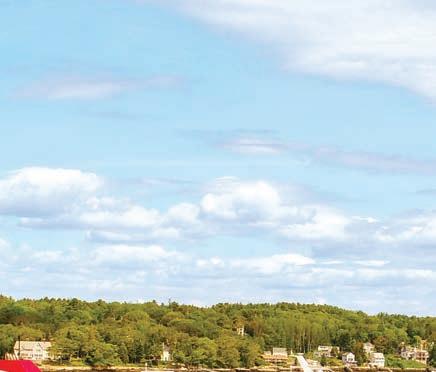





Bangor
Camden
Rockland
Bath
Portland
Portsmouth


Boston
MASSACHUSETTS
Plymouth
RHODE ISLAND



Bar Harbor


Boothbay Harbor
Gloucester
Provincetown






Newport Martha’s Vineyard
Nantucket

Your Grand New England Cruise Includes:
15-days/14-nights on board the ship
An exploration of 15 ports of call, with guided excursion options at each
All onboard meals and our signature evening cocktail hour
Full enrichment package with guest speakers and nightly entertainment
All tips and gratuities
Immerse yourself in the sights, sounds, and tastes of New England. From quaint island villages to the scenic beauty of the coastline, summer in New England is a delightful experience. Enjoy a local Lobsterbake, indulge in the area’s rich maritime history, and witness magnificent mansions of the Gilded Age. Be welcomed back to the comfort of your sanctuary aboard the ship and enjoy the warm camaraderie of fellow guests and crew.
28 /// Flower Power
With her floral-design career blossoming on Nantucket, Hafsa Lewis wants to inspire others to bring the beauty home.
By Meg Lukens Noonan34 /// Made in New England
Steve Smith’s hand-hewed beams give modern homes a sense of history—and a greener outlook.
By Nina MacLaughlin38 /// TV Dinners
Get a taste of the brand-new season of Weekends with Yankee, debuting on public television stations nationwide this April.
By Amy Traverso42 /// In Season
Celebrate Saint Patrick’s Day with two easy (and cozy) recipes filled with Irish flavor. By Amy Traverso
46 /// Weekend Away
Bring your appetite to West Hartford, the foodie town that no one beyond Connecticut’s borders is talking about … yet. By Kim Knox Beckius
52 /// Spring Flings
Say good-bye to winter with colorful, feel-good events and seasonal attractions in every New England state. Compiled by Bill Scheller














 Photo: Gina Campbell
Photo: Gina Campbell







Editor Mel Allen
Managing Editor Jenn Johnson
Senior Features Editor Ian Aldrich
Senior Food Editor Amy Traverso
Senior Digital/Home Editor Aimee Tucker
Travel Editor Kim Knox Beckius
Associate Editor Joe Bills
Associate Digital Editor Katherine Keenan
Contributing Editors Sara Anne Donnelly, Annie Graves, Ben Hewitt, Rowan Jacobsen, Nina MacLaughlin, Bill Scheller, Julia Shipley
Art Director Katharine Van Itallie
Photo Editor Heather Marcus
Contributing Photographers Adam DeTour, Megan Haley, Corey Hendrickson, Michael Piazza, Greta Rybus
Director David Ziarnowski Manager Brian Johnson
Senior Artists Jennifer Freeman, Rachel Kipka
Vice President Paul Belliveau Jr.
Senior Designer Amy O’Brien
Ecommerce Director Alan Henning
Marketing Specialists Holly Sanderson, Jessica Garcia
Email Marketing Specialist Eric Bailey
ESTABLISHED 1935 | AN EMPLOYEE-OWNED COMPANY
President Jamie Trowbridge
Vice Presidents Paul Belliveau Jr., Ernesto Burden, Judson D. Hale Jr., Brook Holmberg, Jennie Meister, Sherin Pierce
Editor Emeritus Judson D. Hale Sr.
CORPORATE STAFF
Vice President, Finance & Administration Jennie Meister
Human Resources Manager Beth Parenteau
Accounts Receivable/IT Coordinator Gail Bleakley
Assistant Controller Nancy Pfuntner
Accounting Associate Meg Hart-Smith
Accounting Coordinator Meli Ellsworth-Osanya
Executive Assistant Christine Tourgee
Maintenance Supervisor Mike Caron
Facilities Attendant Ken Durand
BOARD OF DIRECTORS
Andrew Clurman, Renee Jordan, Joel Toner, Jamie Trowbridge, Cindy Turcot
FOUNDERS
Robb and Beatrix Sagendorph
Publisher Brook Holmberg
ADVERTISING
Vice President Judson D. Hale Jr.
Media Account Managers Kelly Moores, Dean DeLuca , Steven Hall
Canada Account Manager Cynthia Fleming
Senior Production Coordinator Janet Selle
For advertising rates and information, call 800-736-1100, ext. 204, or go to NewEngland.com/adinfo.
MARKETING
ADVERTISING
Director Kate Hathaway Weeks
Senior Manager Valerie Lithgow
Specialist Holly Sloane
PUBLIC RELATIONS
Roslan & Associates Public Relations LLC
NEWSSTAND
Vice President Sherin Pierce
NEWSSTAND CONSULTING
Linda Ruth
PSCS Consulting 603-924-4407
SUBSCRIPTION SERVICES
To subscribe, give a gift, or change your mailing address, or for any other questions, please contact our customer service department:
Yankee Magazine Customer Service P.O. Box 37900 Boone, IA 50037-0900
Online
NewEngland.com/contact-us
Email customerservice@yankeemagazine.com
Toll-free 800-288-4284
Yankee occasionally shares its mailing list with approved advertisers to promote products or services we think our readers will enjoy. If you do not wish to receive these offers, please contact us.
Yankee Publishing





We're that charming New England getaway you've been looking for . . . much closer to home!







Located in the heart of Massachusetts, we are the heart of New England. We're best known as Johnny Appleseed Country but with our scenic countryside, outdoor adventures, quaint shops, orchards and farms, we're so much more.
Travel To - Not Through North Central Massachusetts!
For





DISCOVER THE BEST OF BOTH WORLDS IN BAR HARBOR
Immerse yourself in the heart of Downeast Maine at any of our properties. It's not just a stay; it's a genuine, warm embrace of the Maine way. We focus on you—your comfort, your smiles, and creating the perfect launchpad for your adventures. With seven unique locations in Bar Harbor and Ellsworth, there's a perfect fit for your lifestyle. Stay with us and discover where harmony meets adventure.
n Thanksgiving Day, five friends and I gathered for a traditional meal. We met in one couple’s townhouse that we all agreed was a rental “find” in our southern New Hampshire town. Just steps from Main Street, it featured a porch, a stylish interior, and across the street a pretty library and a waterfall tumbling into the river. For much of our time, we talked about houses, where we might live one day if we uprooted ourselves, and how impossible it has become to find what most of us would call “affordable.” We remembered our own first houses, and how a $50,000 mortgage once felt as though we had suddenly taken on the weight of the world. And we asked how today’s younger generation could even hope to own their own place one day. Our conversation, I am certain, mirrored many others across the country.

I know we face big existential problems— climate change, the fate of our democracy, what an AI future may hold—but what I hear people talk about the most lies closer to the surface: Where can they or their children call home when it seems out of reach for so many?
But the dream is still there. We love to travel; we love sitting at a café or strolling around a harbor, or walking through a historic neighborhood. And even as visitors, we long to stick around. For our “Best Places to Live” feature [p. 54], we summon that dream. We’ve gathered up favorite places we think you’d
want to know, too. Maybe you’ll live in one of them someday, maybe not. But the search often brings rewards of its own.
Also in this issue, we invite you to step inside an extraordinary project at the University of Maine. The ingenuity of its engineers has led to the promise of thousands of efficient, affordable 3D-printed homes, each “constructed” from local wood waste [“The House with 3D Vision,” p. 88]. The project provides a glimpse into a time when we embrace living in a new way, using technology our forebears could never have imagined.
And in “The Hardwick Blueprint” [p. 70], we visit a small town in northern Vermont that’s imbued with a spirit of community and cooperation and looking out for one another. You will come away from this story knowing that what makes any place truly special is the connections we make with those around us. Maybe one day, our children will delight in living in a cozy, affordable house that took shape as if by magic in a giant lab. And when they gather with friends, they will reflect on when they feared they would never know true roots, or truly belong to a place. Now look at us, they will say.
Mel Allen editor@yankeepub.com








JULIA SHIPLEY
“A home is something with emotional resonance for everyone,” says Shipley, an award-winning Vermont journalist and longtime Yankee contributor. In reporting “The House with 3D Vision” [p. 88], she came away deeply impressed by UMaine engineers’ efforts to “provide a safe, lovely, environmentally sound house and home for people in desperate need … and how they are ambitiously, systematically, and creatively engineering infrastructure solutions.”

SUSIE SPIKOL
When not catching frogs with preschoolers, tracking bobcats with middle schoolers, or hawk-watching with her own three children, this New Hampshire naturalist puts her love of the outdoors onto the page [“Ode to Mud Season,” p. 16]. Her writing has appeared in Northern Woodlands, Taproot, and Minding Nature, and she recently published her first book: The Animal Adventurer’s Guide: How to Prowl for Owls, Make Snail Slime, and Catch a Frog Bare-Handed (Roost Books).


TARA ANAND
Originally from Mumbai, India, Anand is a New York–based illustrator and painter who works with clients such as The New Yorker and Apple as well as illustrates children’s books. Whereas creating artwork for “Ode to Mud Season” [p. 16] may have challenged others (“Mud as subject matter is so delightfully gross,” she notes), Anand found grace in the grubbiness. “The meat of my work as a painter is really light and texture, and this allowed me to explore both.”
ROWAN JACOBSEN
Born in rural Vermont, where he’s lived most of his life, Jacobsen has written eight books, including Apples of Uncommon Character and Truffle Hound, and contributed to Harper’s and Outside, among others. Although the author of “The Hardwick Blueprint” [p. 70] tries to maintain a solid wall of journalistic objectivity, he admits that some of his old chicken wire played a key role in a certain papier-mâché head used in the Civic Standard’s Halloween haunted house.


GRETA RYBUS
Saying “it feels like both an eternity and just yesterday” since beginning her career as a photographer, Rybus was excited to put together a retrospective of her work for Yankee, to which she’s been a frequent contributor. But in contrast to her Yankee assignments—often portraits of New England artists and makers, or beautiful travel images—“Home and Away” [p. 76] invites readers along on her globe-trotting journey to document people’s connections to the natural world.
COREY HENDRICKSON
As director of photography for season 8 of Weekends with Yankee, Hendrickson spent months shooting video all across New England—but he still found time to create the deliciouslooking photos for this issue’s food-centric feature on Yankee’s nationally broadcast travel and lifestyle show [“TV Dinners,” p. 38]. A resident of Middlebury, Vermont, where he lives with his wife and two kids, he recently finished a documentary film about food insecurity, Ramen Day, now showing at festivals.


I wanted to thank you for your recent articles on the dangers facing New England due to climate change. Most travel magazines ignore the subject despite the fact that transportation is one of the major contributors of carbon emissions. I love this part of the world and am saddened to see the destruction caused by the extreme weather we now experience. In fact, the ancient South Portland fishing shacks pictured in Jim Westphalen’s photo essay “Vanishing Beauty” [January/February] were destroyed in the storm and high tide of January 14. I hope that by bringing attention to the issue of climate change you can encourage people to travel more responsibly.
Gail Handelmann Stow, MassachusettsI enjoyed the simplicity of your “In Season” fish recipes [January/February] in terms of their ingredients, along with prep and cooking time. I actually tried the first recipe with black sea bass I caught last summer fishing between Point Judith and Block Island. It was absolutely delish, and I look forward to trying the second one.
However, what an insult to hake, sole, and redfish by listing them with tilapia, which is a farm-raised freshwater fish.... One of my favorite bumper stickers can be found on many vehicles in Galilee, Rhode Island: Tilapia is not seafood Because it is not, and should never be listed with any bona fide seafood!
Rick Black Narragansett, Rhode Island

Learning to love the squish of early spring.
I’m an outlier, an admitted rebel. I stand up for things in nature that most people find gross, alarming, or just plain ugly. A short list of animals I love includes carrion-eating turkey vultures, any type of slug, and short-tailed shrews—the only venomous mammal in North America. It isn’t just animals, either. I’d rather bend down to admire a carnivorous pitcher plant than stop to sniff a rose.
When it comes to seasons, don’t expect anything different from me. I’m the one, perhaps the only one, ready to raise my glass and cheer that soft, squishy time of year in New England known as mud season. As winter fades and the temperatures rise, snow melts. Below the melting snow, the deep layers of the ground remain frozen. Combined with early spring rains, a slurry of mud rules the land, making an ordinary walk on a back road a boot-sucking slog.
This isn’t a quick season, either. It has tenacious staying power, starting and stalling in late February and ending in May when the ground has thoroughly thawed. Mud season is a dirty, sloppy, soggy, ugly time of year that makes many New Englanders want to abandon their quaint villages and move somewhere normal, without so much mud.
I say to them: Don’t go.
Instead, grab your best muck boots and sink into this mire with me. See it for what it is—a season full of hope— when winter yields to spring, and the world becomes soft and sweet again.
I know mud season has arrived before any brown slush graces the landscape. It starts on the first warm days of February when the sun feels surprisingly warm, almost tropical. After being frozen for so long, the air smells awake with pine and spice. That’s when I see them: tiny, darkbluish-gray springtails that fill my snowshoe tracks like sprinkled pepper. Springtails, also known as snow fleas, are ancient, petite invertebrates that use their furcula—a forked appendage




on the underside of their abdomen— to fling themselves forward, like corn popping. They gather in my snowy prints, a riot of little bodies searching for mates. I am down on my hands and knees, a witness to this first signpost of my favorite season. If they weren’t so tiny, I would kiss them.
Right around the return of the springtails, the softening ground ushers in the sweetest time of the year: sugaring time. There wouldn’t be maple syrup without the mudproducing freezing and thawing that maple trees need to get their sweet sap flowing. Cold nights in the 20s are fol-
Grab your best muck boots and sink into this mire with me. See it for what it is—a season full of hope.
lowed by warm days in the 40s, loosening winter’s grasp. The sap flows, and the mud oozes. Every year, my sweetheart and I gather with friends at his sugar shack, and we talk win-
ter away with our cups filled with hot syrup and whisky and our faces ruddy with steam. Outside, we grill while our dogs run dirty through the melting snow. I wouldn’t trade these days of sugaring for a trip to the beach. Give me mud if it means there is a sugar shack filled with syrup and friends at the end of the day.
But the thing I love most about mud season is how moist and juicy it is. It is sensual. The frozen earth unbuttons and yields, spreading nutrients back to the plants, so ribbons of grass threaded with wildflowers can carpet the meadows. It is a time of courtship—you can hear it day and night throughout this season. Barred owl pairs hoot, Who cooks for you, who cooks for you all? from bare trees during the deep nights of March, and Okaree! rings from the cattail marsh as male red-winged blackbirds return to their breeding grounds. Skunks scent the air with romance, and bald eagles grasp each other’s talons as they spin and tumble to the ground in a freefalling embrace. At dawn and dusk, courting red foxes light up the browning meadows with flashes of red.
Mourning cloak butterflies dip along roadside mud puddles, fluttering down with curly tongues out to lap up the rich muck. It is the glimpse of these velvet brown butterflies, trimmed in cream with electric-blue spots, that stops me in my tracks. There it is, a butterfly, loving the mud as much as me.
It might not be pretty, and it is definitely messy, but mud season is primordial. It is the soup of life for New England. Without the melt and the ooze, the slosh and squash, spring would be too easy for us. We need mud season. It is our sugar season—when the sweetness of what is to come entices us. It is the tiny chirp of a spring peeper calling from the scrappy brown ground that reminds us that just around the muddy corner, the world still turns, love is in the air, and life continues.

Wander through our 16-acre outdoor living display park. Whether you need a simple shed or a two-story multi-car garage, we’ll help you create an exceptional building.
storage buildings • garages • sunrooms
pool houses • pe rgolas • pavilions
swing sets • patio furn iture & more


Step inside....filled with solid wood American Made furniture and home decor. Come see why folks travel from all over New England. We’re worth the ride!
dining • bedroom • kitchen islands
sofas + sectionals • tv consoles
kitchen cabinet design - build & install



Listening to spring’s siren song at Hancock Shaker Village: peeps, squeals, and bleats from barnyard newborns.
BY JUSTIN SHATWELL PHOTOS BY MEGAN HALEYhe lamb certainly isn’t shy. On knobby knees, it takes its star turn in the middle of a circle of children. Giggling, they dart their hands closer and closer until they summon the courage to pat the creature on its head. The lamb responds with happy bleats and exploratory nibbles on the children’s shorts.
A few feet away, a group of parents—smiling, but clearly undercaffeinated—watch over their flock. When one of the children inevitably asks, “Can we get a pet sheep?” it’s answered with a heavy sigh.
While lambs and children instinctively embrace spring, we who’ve seen

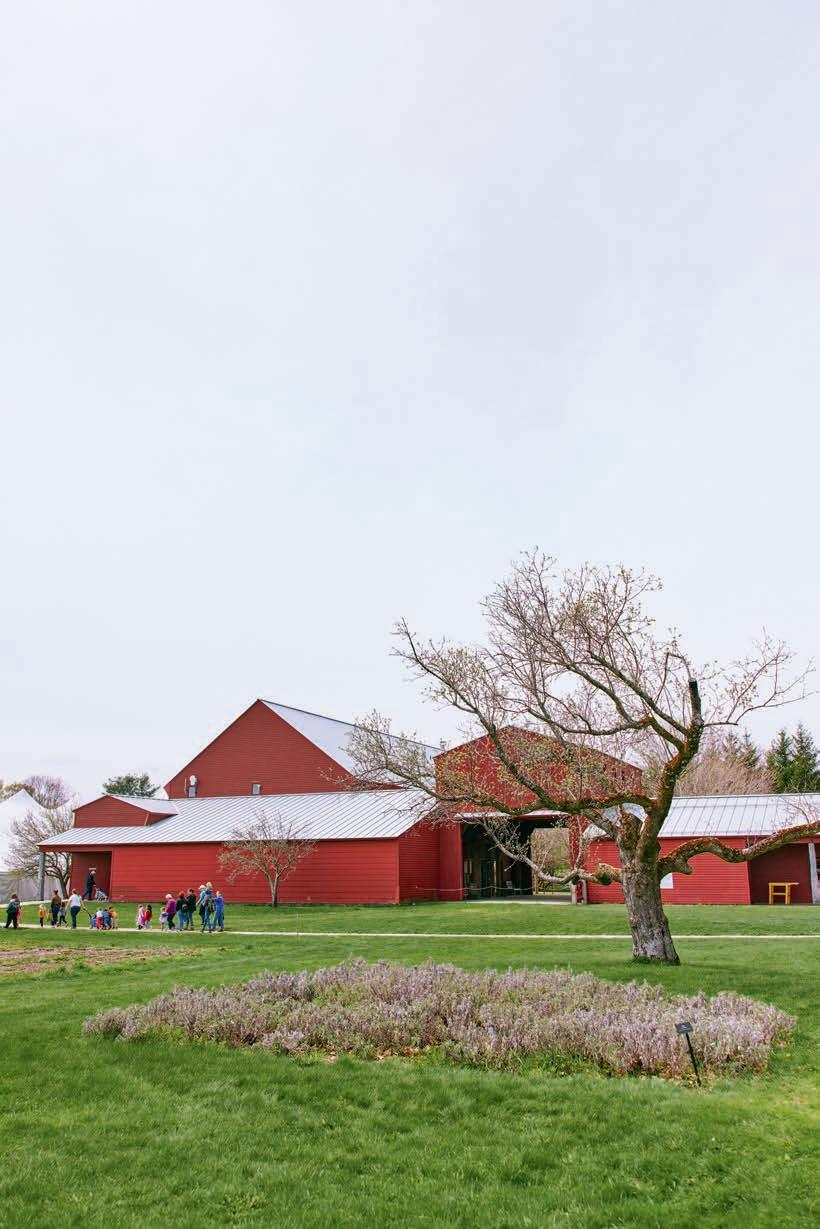

a few need a little more coaxing. As our children run barefoot through the grass, we’re still pulling on wool socks out of habit and wondering if we can push off the first mow another weekend. But since 2002, the unambiguously named Baby Animals Festival at Massachusetts’s Hancock Shaker Village has provided just the jolt some of us need. A chance to get up close with the museum’s newborn animals—it’s a simple idea, but effective. This festival is to spring what a polar bear plunge is to winter; it’s a full-body immersion into everything green and young and new.
An older man approaches the crowd. “I’m Bill Mangiardi, and I’m the farm director of this beautiful place,” he says, then starts herding people onto a hay wagon. It’s an hour before the museum
Who says kids should have all the fun? At The Baldwin — an all-new Life Plan Community (CCRC) — we say this is your time. Make a splash in the pool. Dance, stretch, lift, and box in the tness center. Learn for the love of it. Take to the nearby trails, then top o your day at the local brewery. De ne life on your terms and do whatever you choose — whether that’s everything or nothing at all.
OPEN NOW!
To learn more, call 603.699.0100 or visit TheBaldwinNH.org today.
50 Woodmont Avenue | Londonderry, NH 03053 603.699.0100 | TheBaldwinNH.org



Scan to see the latest video update or go to TheBaldwinNH.org/ Construction_Update

opens, and he’s giving a behind-thescenes tour to two dozen guests, something he’ll do every day of the festival. The lamb, adopted by Mangiardi after being rejected by its mother, trots close behind him as the last guest climbs into the wagon. “Come on, this little one needs a bottle!” he shouts.
Hancock Shaker Village is both a museum and the oldest working farm in the Berkshires. The wagon rolls peacefully by the green buds peeking up in a CSA garden. Donkeys bray from their pen; a mother cow stands protectively over a calf born just yesterday. Beyond the farm stands a line of Shaker dormitories and workhouses, each beautiful in its plainness. The Shakers were utopians who sought to make heaven on earth, which to them meant order, peace, and simplicity. Their minimalist aesthetic is still enchanting to anyone who sees the divine in a right angle and a well-swept floor.

At the heart of the village stands a massive circular stone barn. Inside, mother goats, sheep, and cows rest in pens with their newborns. A particularly vocal ewe greets the tour with a full-throated baaaah . Immediately, Mangiardi encourages children to clamber into the pens. He teases and jokes with them, paying special attention to the shy ones. With a “Here you go!” he surprises one boy by shoving a baby goat into his arms, and in an instant the youngster transforms from timid to beaming. Mangiardi ends the tour by placing a chick on each of the guests’ heads. It’s a silly moment that lets the kids laugh at their parents, and lets the parents laugh at themselves.
Outside the barn, the museum’s gates open and an unbroken column of families begins marching across the grounds. Soon a small parking lot of baby strollers appears along the barn’s curved wall. Mangiardi points to it
and grins. “That’s my favorite sight,” he says.
Inside, the barn is alive with sound. Everywhere parents are lowering children into pens, letting new life meet new life. Above, dozens of birds nesting in the rafters add their song to the chorus of laughs, moos, cheers, and baahs. It’s a peaceful chaos, almost pagan in its freedom. The straitlaced Shakers probably would have disapproved of all this clamor. It wasn’t quite their idea of heaven, but it’s heaven nonetheless.
This year’s Baby Animals Festival at Hancock Shaker Village will be held 4/13–5/5. For more information, go to hancockshakervillage.org.





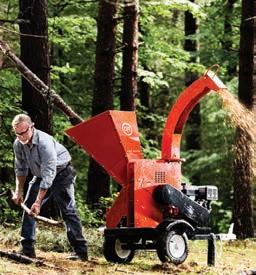




























































































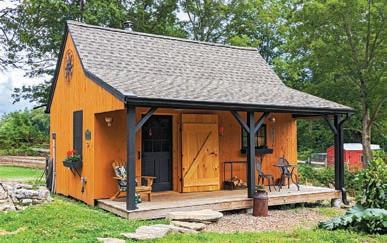








The
Lewis touch can be seen everywhere on Nantucket. She wants others to bring the beauty home.BY MEG LUKENS NOONAN PHOTOS BY EMILY ELIZABETH PHOTOGRAPHY
There’s a saying: All flowers must grow through dirt ,” floral designer Hafsa Lewis tells me over lunch on a sparkling late-spring Nantucket day. “The first time I heard it, it just slapped me in the face.”
It’s easy to see why that expression hit home when you learn how Lewis found her way to floristry—and to a rebirth, of sorts—on this Massachusetts island. A series of traumatizing experiences beginning about a decade ago had left her reeling. First, she was near the Boston Marathon finish line in 2013 when the bombs went off, and she went to the aid of a gravely injured woman. Two years later, she lost her savings in a Ponzi scheme, and then in 2017 her husband abruptly left her. Devastated, she quit her job at a Boston hospital, abandoned her plan to become a mental health counselor—she holds a master’s degree in clinical psychology—and moved to Nantucket to take a bartending gig.
“It was a dark, dark time in my life. I lost 30 pounds. I had no confidence,” she says. “The only time I didn’t feel like I wanted to die was when I was surfing—or playing with flowers.”
Lewis had enjoyed dabbling in floristry as a freelancer for an event planner. But now flowers felt like her salvation, a way to lose herself in beauty when things felt so

bleak. They also presented a path forward. In 2018, she launched Hafsa & Co. as a floral marketing company specializing in the kind of large-scale fresh and faux installations that businesses increasingly use to beautify their spaces, attract customers, and generate social media hits. After attending workshops in her native England, as well as in Ecuador and Mexico, to learn the mechanics of the displays (hint: it’s all about chicken wire and zip ties), she started building her portfolio.
Among Hafsa & Co.’s most enthusiastic clients is Lemon Press, the airy organic café where we’ve met for lunch. It’s owned by cousins Darya Afshari Gault and Rachel Afshari, who happen to share Lewis’s Persian heritage and her belief in the magic of flowers.
“Our first install with Hafsa was [a small piece] over the coffee bar,” says Gault. “It was so well-received— people would come in just to Instagram
it—we said, ‘Wow, let’s keep going.’ ”
Now, the Hafsa & Co. touch is everywhere at the café. An ethereal 16-foot swag of preserved white blooms—hanging amaranthus, lunaria, helecho fern, and others— graces a brick wall in the dining area; a canopy of faux wisteria dangles over the bar; and a border of foraged grapevines and silk daffodils and forsythias frames the eatery’s exterior doorway. (Lewis would soon be shifting that seasonal entrance display to summery spray roses and ranunculus.)
Lewis has also “flowered” the Artists Association of Nantucket gallery, the Nantucket Hotel, the Nantucket Dreamland movie theater, and a host of boutiques both on and off the island. She’s done displays for annual events including the Nantucket Wine & Food Festival, the Christmas Stroll, and the Daffodil Festival; made custom pieces for private parties (floral crowns, anyone?); and presented workshops for aspiring florists.
In 2021, the noted Los Angeles–based fine-art photographer Gray Malin enlisted Lewis to create elaborate floral props for a series of vignettes he’d come to the island to shoot. That same year and again in 2022, the local Coast Guard station asked her to put her creative touch on the iconic seasonal wreaths—daffodils in spring and poinsettias at Christmastime—that it hangs on the Brant Point lighthouse. (Lewis wasn’t involved with the 2023 daffodil wreath, which was delayed by lighthouse renovations, and then made and hung at the last minute by the Coast Guard when repairs were complete.)
Like most small-business owners, she’s faced challenges. When Covid hit, she stayed afloat by making and delivering $50 bouquets with inspirational messages to residents who


Nantucket’s Sign Advisory Council questioned whether her temporary outdoor installations were technically “signs” and therefore subject to a permitting process, a red tape–heavy requirement that likely would have sunk her business. Some detractors also sniffed that her displays were not appropriate on Nantucket.
Lewis went to every council meeting for six weeks to argue that her pieces were not signs—and that they were no different from the flower boxes most shops maintain. “I also wanted them to know the reason they were seeing more installations is because our community wants them. They make people happy.”
The controversy ended when the town unexpectedly ordered the council to disband before it made any recommendations. “And I’m still here to flower another day,” she says, smiling broadly.
Through it all, Lewis has remained mindful of what drew her to flowers: their power to heal, to express joy and sorrow, and to forge connections.
“The science part of my brain,” she says, “is really interested in how therapeutic flowers can be”—so interested, in fact, that she’s starting a doctorate program in clinical psychology this year with the idea of one day using flowers in a counseling practice.
“We have art therapy and pet therapy,” she says. “Why not flower therapy?”
There’s a bit more to the tale of how Hafsa Lewis blossomed on Nantucket. Those Coasties she helped with the lighthouse wreaths? Last summer, she married one of them.
“It was such a ‘meet cute,’” she says. “My friends tell me my life should be a Hallmark movie.” hafsaandco.com
Granted, you’re probably not planning to erect an elaborate floral installation in your home. But Hafsa Lewis says the principles behind her “big stuff” apply to the simplest arrangements, too.
l Picking your flowers: “Go with the ones that make you feel something,” she says, “whether it’s a $24 stem or a sad-looking Charlie Brown–type grocery-store flower. If you’re moved enough by something that nature’s created, and it sparks joy inside of you, then you should take it home and make it your own.”
l Choosing your vessel: “Pick one that allows your flowers space to breathe. If they’re stuck in a vase that just stands them straight up, they can feel stiff. That’s not how they are in nature. They grow loose and wild and free. Let each flower have its moment—it doesn’t matter if it’s the side or the back or the front of the stem. Flowers are beautiful from all angles.”
l Setting up for success: “First, make sure your vessel is clean. Remove any leaves from the stem that would be under the waterline, since submerged leaves can cause bacteria that will shorten the flowers’ shelf life. Give the stems a fresh cut before you put them in water.”
l Taking your time: “I often walk away from a piece for a while so that I can come back to it with fresh eyes. And I take pictures in order to get a different perspective. That helps me see what’s missing and what I could do differently. I think that works for both large- and smallscale things.”
l Honing your skills: Lewis recommends photographing one arrangement you do now and one you do in six months, then studying the pictures to see what you’ve done differently and what has stuck with you. “Did the shape change? Did you pick different colors? Once you start to pay more attention, you learn what you like and what is most meaningful to you.”



Using only an ax, Steve Smith resurrects the centuries-old craft of hand-hewing to bring both history and new life into today’s homes.
BY NINA MACLAUGHLINThe thunk comes first, the sound of ax through wood. It’s a sound that registers in the body as much as the ears, a sound that one feels in the center of oneself: the exchange between blade and trunk, forces of muscle, bone, gravity, and tree, and then the whisper of wood-chip shrapnel landing on the grass.
Such is the aural landscape of Renaissance Timber in Cumberland, Maine, where Steve Smith practices the craft of hand-hewing, taking the round trunk of a tree and shaping it into a square beam. No power tools, no screaming saws or spinning blades. Just his body, the tree’s body, the ax.
And what results—structural beams and mantels of white pine, cedar, cherry, oak—breathe with life and history. They take their places in homes, above the hearth or supporting the ceiling, and become part of the soul of the place. They draw the eye, and more than the eye.
“People are homesick for imperfection,” says Smith. Every mark you see on one of his beams was a decision, part of an intimate connection between man and tree. “It’s a conversation between souls,” he says. And that conversation reverberates, providing a palpable sense of warmth absent from the sterility of industrialized

perfection. And it will last longer, too.
Smith, 43, talks of the planned obsolescence of modern-day building materials. “The stuff I’m making will be here 200 years from now,” he says, the wood speaking to the future as well as the past in its rough Maine vernacular. It’s a legacy item, he says, and to be in a room with wood he’s hewed is to “step into the river of history. It gives a sense of movement in a way that sheetrock doesn’t.”
Smith’s evolution as a hand-hewer has its roots in the past as well. His great-great-grandfather drove logs downriver in Maine; another sold used lumber. And Renaissance Timber is based on the farm where Smith grew
up. A sense of heritage is important to him, the circle of life and growth and connection. When we met, he’d just finished building a small cabin playhouse for his two boys and was readying to turn the front section of the dairy barn into a showroom. The trees he uses come from his land, or that of his clients; the carbon footprint of his work is zero.
We met on a bright, warm September afternoon, the autumn equinox, and Smith was hewing a tree by the barn as the sun made the grasses glow gold in the field to the south. He’d marked the edges and snapped chalk lines down the length of the trunk; he’d stood on one side of the tree and axed a series of wide notches, concave openings every 18 inches or so. And then, with left knee resting on the log and right foot planted on the ground, he raised the ax and brought it down, that great deep thunk, jogging out the sections between the wide inviting openings, fragments of wood flying through the afternoon light.
Broad of shoulder, thick of bicep, Smith does not have the vanity-driven
THIS PAGE: A partially hewn stool shows the alchemy of Steve Smith’s work: transforming round logs into square beams.
OPPOSITE: Smith holds a bearded broad ax that he had custom-forged by another Maine traditionalist, blacksmith Nick Downing.


chiseled form of a gym-goer but the fullbody strength of someone who uses that body for his work. It hasn’t always been so: He’s relatively new to hand-hewing, having started the business in 2019. Working a white-collar job, he tore his bicep lifting something heavy, tweaked his back logging so many hours at a desk, and worse, knew the staticky fuzz of being in front of a screen all day. Then a book crossed his path, A Reverence for Wood by Eric Sloane, and he watched the hewing process on YouTube. He took down a cedar and gave it a shot. “It resonated,” he said. While his days in front of a screen blurred together as one, “I remember every place I’ve been in the woods for clients. I remember the bugs, the temperature, the light.”
Smith carries himself with the humility of someone who’s asked himself the hard questions, recognized the painful fact that how he’d understood the world was wrong, and had the courage to make a change. He has the spark in his eye that people who are in intimate relationship with the land have,



















LED bulbs use less energy and last longer than their fluorescent counterparts. Not to mention they give off less heat and offer more flexibility in color, dimmability, and directional lighting.

Planning to travel this spring? Limit greenhouse gas emissions by ditching those planes and automobiles in favor of trains, a more sustainable mode of transportation.




Join us for a unique farm-stay experience that your family will never forget. We’re proud to be Vermont’s first certified Green Agritourism Enterprise and a member of Cabot Creamery, a farmer-owned cooperative and certified B Corp.
ROCHESTER, VT | (802) 767-3926
LIBERTYHILLFARM.COM
ROCHESTER, VT | (802) 767-3926
LIBERTYHILLFARM.COM

Choosing broccoli over bacon isn’t just good for your body: Studies show that reducing meat consumption is a great way to shrink your carbon footprint.


Potato peels and eggshells do far more good in your garden than in a landfill. Starting a compost pile lets you add nutrients back into your soil while cutting down on what you lug to the dump.


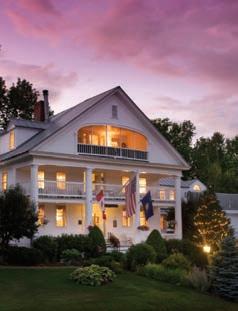

Rabbit Hill Inn aims to minimize its environmental impact, while still providing a luxury getaway experience. A guest favorite is our sustainable bottled water program. Glass water bottles are filled from an on-site natural spring and placed in the rooms and throughout the inn.
LOWER WATERFORD, VT | (802) 748-5168 | RABBITHILLINN.COM


Celebrating 15 years!
Thousands of happy customers continue to enjoy Owl Furniture’s comfortable postural support and ergonomics. Join the party!
HANDCRAFTED BEAUTY
SUSTAINABILITY COMMITMENT MADE IN MAINE
ROCHESTER, VT | (802) 767-3926
LIBERTYHILLFARM.COM
STONINGTON, ME | (207) 367-6555
OWLFURNITURE.COM
Senior food editor Amy Traverso chats with Jonathan Laurence, captain and founder of Moon Dog Excursions, during a Weekends with Yankee shoot in Camden, Maine.

Taste a preview of the new season of Weekends with Yankee, coming to public television stations nationwide in April.
BY AMY TRAVERSO | PHOTOS BY COREY HENDRICKSON | STYLING BY LIZ NEILYTo make the eighth season of Weekends with Yankee , the public television show that we produce with Boston’s GBH, I traveled across New England by skiff, by lobster boat, and by hayride. I hiked the dunes of Cape Cod to collect beach plums for jam, made honeyberry ice cream in the White Mountains, fried cider doughnuts at an orchard in Massachusetts, drank Maine-made bubbly in a treehouse hot tub, and ate a scallop fresh from the
waters off Stonington, Maine. In short, it was a season of adventures, stunning scenery, and culinary delights. I hope you’ll tune in as we roll out 13 new episodes over the coming weeks, and that you’ll enjoy watching them as much as we enjoyed making them.
To whet your appetite, here are five recipes from season 8, along with the stories that inspired them. To find all the recipes we made over the course of filming the show, go to newengland.com/tv-dinners.
 A bright gremolata of fresh parsley, garlic, and lemon zest pairs with creamy pasta and delicate lobster in this dish from acclaimed Maine restaurant Aragosta (recipe, p. 40).
A bright gremolata of fresh parsley, garlic, and lemon zest pairs with creamy pasta and delicate lobster in this dish from acclaimed Maine restaurant Aragosta (recipe, p. 40).
Chang Thai Café | Littleton, NH
A native of Bangkok, Emshika Alberini moved to the U.S. to study business but changed course after her beloved sister, Sriwipha, passed away in 2006. Her sister’s dream had been to open a modern Thai restaurant, so Emshika made that dream her own. She’s been earning culinary accolades ever since with her Littleton restaurant, Chang Thai Café.
On a peak-foliage fall day, I visited the home that Emshika shares with her children and mother, “Mama Nee” Ketsatin, to make pumpkin curry. I’ve had Thai red curry before, but never anything this good. This easy, flavor-packed dish is now in my regular weeknight rotation.
If you don’t have access to a market with a decent selection of Thai ingredients, you may need to go online to source three key ingredients: red curry paste, fish sauce, and kaffir lime leaves (feel free to use dried lime leaves instead of fresh). The recipe also calls for Thai basil, but you can substitute the more common sweet Italian basil. And vegans can make the dish without chicken—just add tofu or an extra pound of squash.
Note: Emshika recommends using Thai fish sauce, such as Squid brand. For red curry paste, she and her mother either make it from scratch or use Maesri brand. For coconut milk, you’ll get the creamiest results if you use the full-fat version, but you can certainly use the reduced-fat type.
1 tablespoon vegetable oil
2 tablespoons Thai red curry paste
2 cups coconut milk
½ medium peeled and seeded kabocha squash, sugar pumpkin, or butternut squash, cut into 1-inch cubes (about 1 pound)
1 pound boneless, skinless chicken breast or thighs, cut into 1-inch pieces
3 kaffir lime leaves, torn
2 tablespoons fish sauce, plus more to taste
Yankee’s national travel and lifestyle series, WEEKENDS WITH YANKEE, kicks off its new season this April on public television stations across the country. To find out how to watch, go to weekendswith yankee.com.
3 tablespoons brown sugar, plus more to taste
½ teaspoon kosher salt
C ooked jasmine rice, for serving
1 sliced serrano, jalapeno, or other chili pepper (optional)
½ cup chopped Thai basil or sweet Italian basil
Warm the oil in a 4- or 5-quart Dutch oven over medium heat. Add the red curry paste, stir, and let it cook for a minute, then whisk in the coconut milk.
Add the squash, chicken, kaffir lime leaves, fish sauce, brown sugar, and salt and cook until the squash is tender and chicken is cooked through, 20 to 30 minutes.
Serve the curry over cooked rice and sprinkle with chili (if using) and basil. Serve hot. Yields 6 to 8 servings.
LOBSTER PASTA
Aragosta | Stonington, ME
The dirt road that leads down to Goose Cove is so exquisitely bordered by spruce, moss, and aspens that we were in a reverie by the time we pulled up to Aragosta, the storied farm-to-coast-totable restaurant and inn in Stonington. Piling out of our cars, we blinked at the sweeping view of sandy beach and East Penobscot Bay for just a moment before chef-owner Devin Finigan stepped out of the kitchen, prepped and ready to cook.
In Italian, aragosta means lobster, and the one dish that Devin can never take off her menu is the agnolotti with lobster and beurre blanc. This stuffed pasta dish is a signature, one that she was kind enough to adapt into something that
a home cook can easily make, provided you’re willing to buy precooked lobster meat (or steam and shell your own). It’s a splurge, but it’s absolutely worth it.
1 tablespoon minced garlic
1 tablespoon minced fresh parsley
1 tablespoon freshly grated lemon zest
1 p ound cooked lobster, cut into bite-size pieces
½ cup mascarpone cheese
1 tablespoon lemon juice
Freshly grated zest of 1 lemon
1 small garlic clove, minced
¼ cup chopped fresh parsley
Kosher salt, to taste, plus more for pasta water
12 ounces dried linguine or tube-shaped pasta
½ cup dry white wine, such as pinot grigio
1 small shallot, minced
2 tablespoons unsalted butter, cut into small cubes
2 tablespoons heavy cream
First, make the gremolata: In a small bowl, stir together the garlic, parsley, and lemon zest. Set aside.
Now, make the lobster mixture: In a large bowl, use a spatula to fold the lobster meat with the mascarpone, lemon juice, lemon zest, garlic, and parsley. Add salt to taste. Set aside.
Set a large pot of salted water over high heat and bring to a boil. Add pasta and cook according to package instructions until it is still just a bit firm in the center, or al dente.
Meanwhile, in a large skillet over medium-high heat, bring the wine to a simmer with the shallot. Simmer until the wine reduces to about 2 tablespoons. Add the butter, a few cubes at a time, whisking as you go. It should blend in and look creamy. Add the cream and stir until the sauce








 Amy joins chef Dan Coté in the Pelham House Resort kitchen for a walkthrough of his clam chowder (RIGHT). Recipe, p. 94
Cider doughnuts meet bread pudding in a delectable dish (LEFT) inspired by Cider Hill Farm, which is tended by field manager Grigore Chitas and his family.
Recipe, p. 94
“Mama Nee” Ketsatin makes Thai pumpkin red curry (LEFT), a favorite offering at daughter Emshika Alberini’s Chang Thai Café.
Amy joins chef Dan Coté in the Pelham House Resort kitchen for a walkthrough of his clam chowder (RIGHT). Recipe, p. 94
Cider doughnuts meet bread pudding in a delectable dish (LEFT) inspired by Cider Hill Farm, which is tended by field manager Grigore Chitas and his family.
Recipe, p. 94
“Mama Nee” Ketsatin makes Thai pumpkin red curry (LEFT), a favorite offering at daughter Emshika Alberini’s Chang Thai Café.

Celebrate Saint Patrick’s Day with this pair of easy (and cozy) recipes.
BY AMY TRAVERSO STYLED AND PHOTOGRAPHED BY LIZ NEILY
ormally, I develop recipes for this column based on an ingredient that comes into season at the same time each issue hits your mailbox. And every year, March presents a challenge: In early spring, there isn’t much in the way of fresh produce on offer. Newfoundlanders traditionally called March “the long and hungry month,” a reference to the waning stores in their root cellars. Of course, there’s always maple syrup. But this year, my mind turned to Saint Patrick’s Day and Irish food.
Specifically I thought of colcannon, a dish of mashed potatoes, shredded cabbage or kale, and herbs. I like to make it with Napa cabbage and scallions, two green ingredients that give flavor and character to the spuds (and add nutritional value, too). And while colcannon is usually served as a side dish, it makes a fine topping for a simple shepherd’s pie, which you can make with beef or lamb, and which gets its added layers of flavor from a dollop of tomato paste and Worcestershire sauce.
For dessert, I decided to take a classic chocolate Guinness cake and reimagine it as brownies. This took many testing attempts to perfect, since brownie recipes don’t usually incorporate liquid ingredients. But the stout adds a lovely flavor that’s almost gingerbread-like. And you can make the batter in one pot in a matter of minutes. So much for a long and hungry month.
Tasting Boxes, Gifts, Gift of the Month Clubs I Leave the Sending to Us!




Tasting Boxes, Gifts, Gift of the Month Clubs I Leave the Sending to Us!






Kosher salt, to taste, plus more for the cooking water
1½ pounds Yukon Gold potatoes, peeled, cut into 1-inch chunks
4 tablespoons salted butter, divided
2½ cups shredded Napa cabbage
2 scallions, all parts except root, thinly sliced crosswise ²⁄3 –1 cup milk, warmed
Freshly ground black pepper
3 tablespoons olive oil, divided
1½ pounds ground beef or lamb
1½ teaspoons kosher salt, divided 2 carrots, diced
2 celery stalks, diced
1 medium onion, diced
3 garlic cloves, minced
1 teaspoon dried thyme
1 teaspoon freshly ground black pepper
3 tablespoons tomato paste
1 tablespoon Worcestershire sauce
3 tablespoons all-purpose flour ½ cup beef or chicken stock, or stout
First, make the topping: Put the potatoes in a medium pot with enough
salted water to cover them by 1 inch. Bring to a boil, then reduce heat to medium and simmer until tender, 12 to 15 minutes. Using a strainer, remove the potatoes to a bowl and set aside. Discard the water.
Return the pot to medium heat. Add 2 tablespoons butter, swirl to melt, then add the cabbage and scallions and cook, stirring, until tender, about 5 minutes. Season with a pinch of salt. Return the potatoes to the pot and mash until nearly smooth. Add the milk and remaining butter, stirring and mashing until creamy. Season with salt and pepper. Cover and set aside.
Preheat your oven to 375°F and set a rack to the middle position. Now, make the filling: In a large skillet, warm 1 tablespoon oil over mediumhigh heat. Add the beef or lamb and ½ teaspoon salt and cook, stirring and breaking up the meat, until no longer pink, 7 to 9 minutes. Transfer to a bowl with a slotted spoon.
Remove all but 1 tablespoon fat from the skillet; return to medium heat. Add the remaining 2 tablespoons oil. Add the carrots, celery, onion, garlic, thyme, pepper, and remaining 1 teaspoon salt. Cook, stirring occasionally, until vegetables are softened and a bit browned, 6 to 8 minutes. Add the tomato paste and Worcestershire sauce
and stir until the vegetables are coated. Return the meat and any juices to the skillet. Sprinkle the flour over all and cook, stirring, for 1 to 2 minutes. Add the stock (or stout) in a slow stream, stirring as you go. Simmer until the mixture has thickened slightly, 1 to 2 minutes. Remove from heat.
Spoon the topping in dollops over the filling. Use the back of a spoon to gently spread it evenly over the top. Bake until golden brown in places and bubbling along the edges, 30 to 35 minutes. Let sit for 10 minutes before serving. Yields 6 to 8 servings.
CHOCOLATE STOUT BROWNIES
1 cup (2 sticks) unsalted butter
½ cup Guinness or other stout
½ cup unsweetened cocoa powder
1¾ cups granulated sugar
2 large eggs, beaten
1¼ cups (175 grams) all-purpose flour
1 teaspoon baking soda
1 teaspoon table salt
Preheat your oven to 350°F. Take a 9-by-13-inch baking pan and cut 2 lengths of parchment paper to fit in the pan but long enough to hang over the sides by a few inches. Lay them in the pan, one in each direction, so they cover the bottom.
In a 3- or 4-quart pot over medium heat, melt the butter with the stout and whisk to combine. Remove from heat and whisk in the cocoa powder. Add the sugar and whisk until smooth. (Each addition will lower the temperature of the batter.) Whisk in the eggs.
In a medium bowl, whisk together the flour, baking soda, and salt. Add the dry ingredients to the wet, and stir with a spatula until smooth and evenly combined. Pour the batter into the prepared pan and bake until the brownies are set in the center and beginning to pull away from the sides, 30 to 45 minutes. Let cool in the pan and then transfer to a rack or plate to cool completely. Yields 12 to 16 servings.

Lady Captain’s SparHawk Maine Tourmaline Ring G4685...$1,350


Wellspring SparHawk Maine Tourmaline & Diamond Ring X3823...$2,650

Olympian Winner SparHawk Maine Tourmaline Ring G4698...$2,275

Revere SparHawk Maine Tourmaline & Diamond Ring G3080...$4,375

The Schooner SparHawk Maine Tourmaline & Diamond Ring G4192...$6,150

Star Light, Star Bright SparHawk Maine Tourmaline & Diamond Necklace G4573...$3,075

SparHawk Maine Tourmaline & Diamond Earrings G3709...$4,875
We’ve been mining gems in Maine for over two-hundred years. Something amazing happened in our Western Mountains 12 years ago. One of the richest finds of tourmaline in the world occurred just 25 miles north of Portland. The tourmaline find was amazing, it was called SparHawk, It had some of the prettiest green tourmaline ever found in Maine’s Western Mountains.
The large picture is a glimpse into the Silver Dollar Pocket. A cave in a cliff. Tourmaline crystals were covered with a type of white clay that when washed away revealed green tourmaline crystals of extraordinary color and clarity.
The large SparHawk tourmaline crystal held in the smaller picture came from the Silver Dollar Pocket and is now in the Smithsonian Museum in Washington D.C.
is always Safe, Fast and


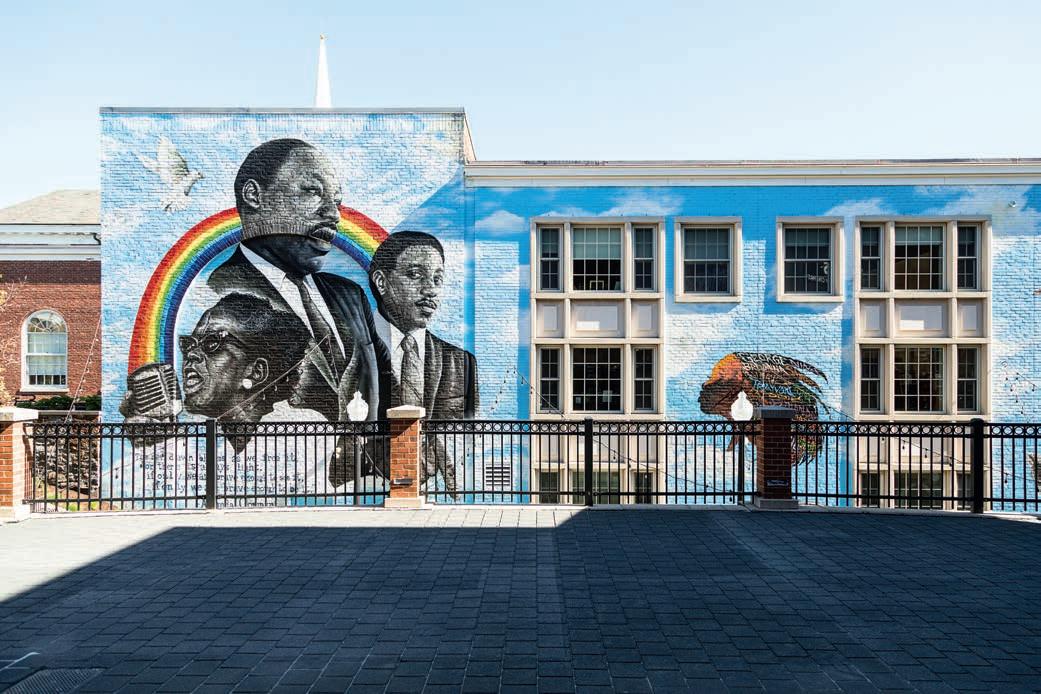
THIS CULTURED SUBURB IS THE FOODIE TOWN NO ONE BEYOND CONNECTICUT’S BORDERS IS TALKING ABOUT … YET.
 PHOTOS BY JULIE BIDWELL
PHOTOS BY JULIE BIDWELL

 THIS PAGE: Àvert Brasserie lends a soupçon of French flavor to West Hartford’s sidewalk dining scene. OPPOSITE, CLOCKWISE FROM TOP LEFT: Ella Baker, Martin Luther King Jr., and Bernard Lafayette Jr. grace a mural by Corey Pane in Blue Back Square; blooming wonders in Elizabeth Park; a passel of pots at Moscarillo’s Garden Shoppe; elevated Peruvian fare at Coracora.
THIS PAGE: Àvert Brasserie lends a soupçon of French flavor to West Hartford’s sidewalk dining scene. OPPOSITE, CLOCKWISE FROM TOP LEFT: Ella Baker, Martin Luther King Jr., and Bernard Lafayette Jr. grace a mural by Corey Pane in Blue Back Square; blooming wonders in Elizabeth Park; a passel of pots at Moscarillo’s Garden Shoppe; elevated Peruvian fare at Coracora.

I’ve never been to Paris in the springtime, but I’ve been to West Hartford. Don’t laugh-cry for me. Connecticut’s own little slice of Europe is one of those “if you know, you know” places that many travelers overlook. It’s equidistant from Boston and New York City, and you’d be hard-pressed to find a few-block area in either metropolis with the variety of cuisine that awaits in this sophisticated suburb with 63,000 residents and two Whole Foods Markets. When temperatures nudge up in April, out come the sidewalk tables, the street musicians, the couples of all persuasions strolling hand in hand through West Hartford Center and adjacent Blue Back Square. Up spring the tulips, in parks with architectural features and flowering trees worthy of Impressionist paintings.
I’ve known West Hartford for half my life, but I sometimes forget how rich it is in Connecticut-centric shopping. In places to walk. In neighborhoods like Elmwood and Bishops Corner, with their own character and restaurant finds. How steeped it is in history.
The newest commercial district is named for local son Noah Webster’s Blue Back Speller. His birthplace is one of 41 notable locations mapped on a weathered sign on South Main Street, not far from his 13-foot marble likeness, sculpted for the town by Korczak Ziolkowski of Crazy Horse Memorial fame. I feel like a slacker as I circle the statue of my dictionary idol, reading his credits: Activist, Author, Educator, Farmer, Journalist, Patriot, Publisher, Scholar.
There is value in slacking, though. So I’ve been weekending in WeHa often with the aim of setting to rest a question I hear perennially from Connecticut friends: Why doesn’t anybody write about West Hartford as a destination?
Truthfully, it’s with some reluctance. Can I live with longer lines for my food-truck favorites at the year-round GastroPark (oh, Hindsight Barbecue, you slay me with your pulledpork mac and cheese)? Could it become more challenging to secure a table at Coracora, a foodie magnet since chef Macarena Ludena’s Peruvian dishes earned this unassuming Elmwood eatery (it’s in a former McDonald’s) a 2023 James Beard Award nomination for most outstanding restaurant in the country?
And what about divulging secrets like the labyrinth concealed in the forest behind

DORO Marketplace: The pastries are scrumptious, but don’t miss the homemade bagels, fried-chicken sandwiches, sourdough pizza slices, and Connecticut-roasted Shearwater coffee drinks. doromkpl.com
Sparrow Pizza Bar: In a state known for pizza, leave it to Chopped grand champ Adam Greenberg to prove “New Haven style” is not the only way to go. The bar here stays lively until midnight on weekends. sparrowpizzabar.com
Coracora: Accolades pour in for this familyowned Peruvian standout. Head chef Macarena Ludena worked her way up from bussing tables in her parents’ restaurant, and recently her empanadas, ceviches, and fried whole sea bass earned 2023 Connecticut Restaurant of the Year honors. coracoraeats.com
DORO Restaurant Group: Any one of DORO’s three West Hartford Center restaurants would warrant a road trip. How about nibbles at all three? Mussels aux frites and fondue at Àvert Brasserie, ricotta-stuffed zucchini blossoms and the ravioli del giorno at Treva, and seasonally inspired hummus and colossal roasted cauliflower at Zohara dororg.com
Delamar West
Hartford: With its own farm-to-table-focused Artisan restaurant

Copper Beech Institute, a nonreligious mindfulness-education nonprofit at Holy Family Passionist Retreat Center? It’s open free to anyone. Whenever I’ve lost myself in its twists—aimlessly aiming for the moon gate at its center—it’s been mine alone, save for the songbirds, the whistle of budding branches.
I’m reminded of the benefits of sharing when I meet my West Hartford–based friend Jeannette at DORO Marketplace on a sunny April morning, and we select eight handcrafted French-butter pastries including a filled, glazed, nut-sprinkled pistachio croissant puffy enough to fill me all day. On the patio, dressed with lush plants from Moscarillo’s, we chat with DORO Restaurant Group owners Dorjan and Mira Puka: Albanian immigrants
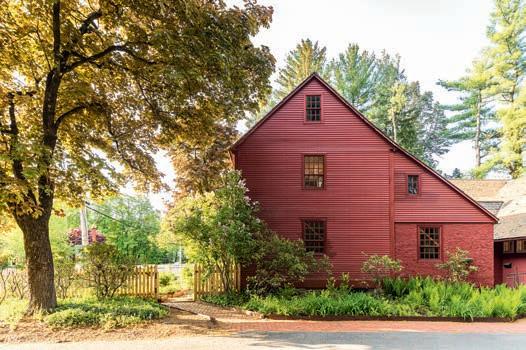
who’ve helped internationalize West Hartford Center with their Treva (Italian), Àvert (French), and Zohara (Mediterranean) restaurants. As our conversation meanders from the extraordinary food scene to the uniqueness of this community—where art, education, and history are revered, businesses collaborate, and being outdoors is central to life—it’s clear I can’t keep WeHa under wraps.
Just where to send you, though, when in West Hartford Center alone you’ll also find top-notch Afghan, American, Caribbean, Chinese, Japanese, Mexican, steak, and seafood restaurants? Jeannette and I contemplate this at celebrity-chef-owned Sparrow Pizza Bar, where toppings like ramps and pesto are splashed to the outer edges of crispy pies. Our debate continues at the West Hartford Reservoirs, where 30 miles of trails are open to walkers, runners, and cyclists. “You’ve made me fall in love with my town all over again,” she says, as we realize for every recommendation in this guide, we have a handful more. So, visit while West Hartford’s still relatively undiscovered. And please let me know if there’s an extra seat at your table.
and a spa that spoils guests and locals, you could spend all weekend luxuriating here, even though chauffeured tours are available and all of Blue Back Square and West Hartford Center is on your doorstep. delamar.com
PLAY
Elizabeth Park: Known for its roses, this late-19th-century landscape on West Hartford’s eastern edge fires up its cavalcade of color earlier than you might expect. A fragrant and photogenic greenhouse show in March is followed by unimaginable deals on unique and heirloom bulbs. By late April, more than 10,000 tulips shimmer and shine. elizabeth parkct.org
Noah Webster House: Tablet tours allow you to dive as deeply as you’d like into the history and stories that reverberate through the house where “America’s Schoolmaster” grew up. Purchase West Hartford–themed gifts, and support programming for all ages including poetry readings and Life on the Farm demonstrations. noah websterhouse.org
SHOP
Moscarillo’s Garden
Shoppe: Whatever weather spring may bring, you’ll feel sunny and light on a walk through the immense greenhouse at this fifthgeneration-owned plant emporium near Bishops Corner. moscarillos.com









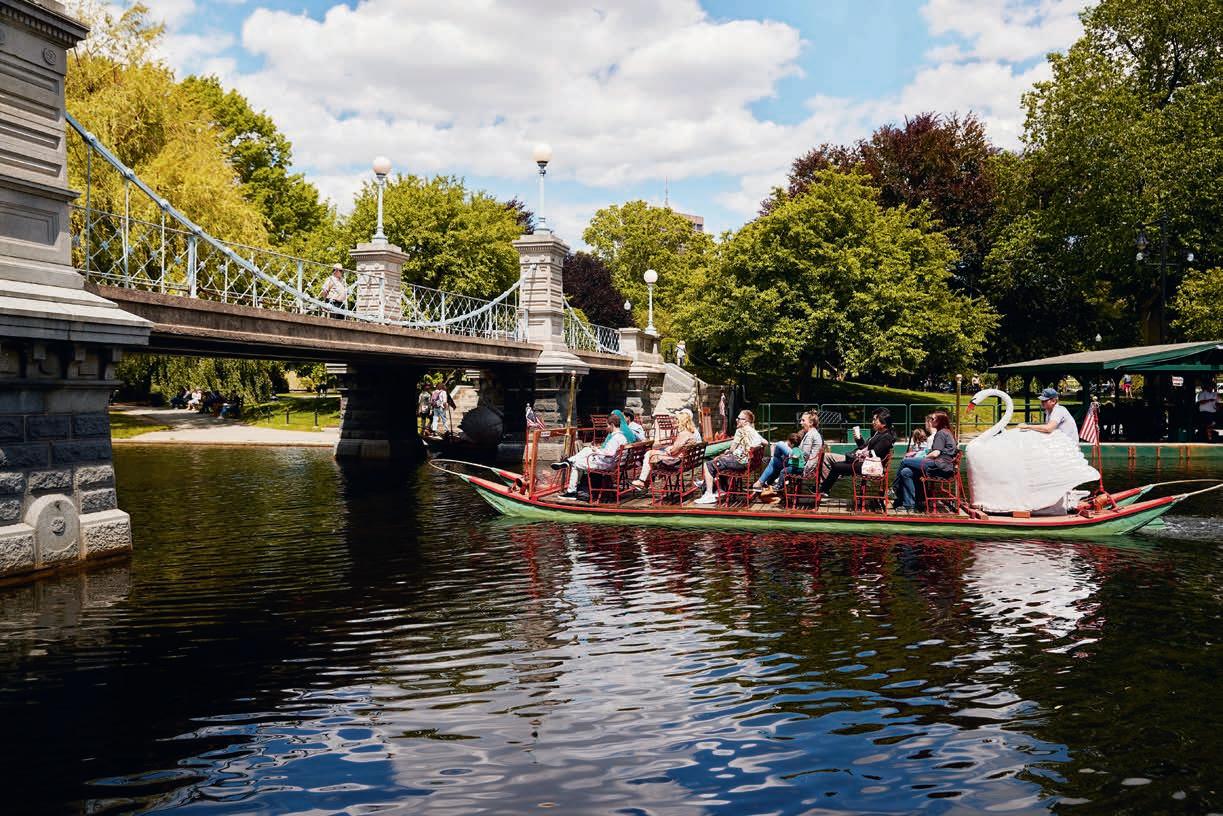
CHERRY
BLOSSOM CELEBRATION,New Haven. Back in 1973, New Haven’s parks department planted 72 Japanese flowering cherry trees in Wooster Square Park. The trees’ bounty of pale-pink blossoms emerges over the course of two weeks in April, an abundance marked by the Historic Wooster
Square Association’s annual community event featuring music and food vendors. 4/14; historicwoostersquare.org
COLORBLENDS HOUSE & SPRING GARDEN, Bridgeport. A 1903 Colonial Revival mansion in the city’s historic Stratfield district is the backdrop for a half-acre garden featuring nearly 100,000 bulbs:
tulips, daffodils, crocuses, narcissus, and many more spring-flowering favorites. The garden, created by Dutch floral landscaper Jacqueline van der Kloet, was designed to inspire home gardeners, who are invited to stroll the property and tour the house and art gallery when blooms appear in early April. Check website for details; colorblendsspringgarden.com
DENISON HOMESTEAD DAFFODIL DAY, Mystic. Mystic’s 1654 Denison Homestead hosts this celebration of the surrounding nature center’s thousands of daffodils. Look for tours of the 1717 Pequotsepos Manor and its gardens, demonstrations of open-hearth cooking, and children’s activities including crafts and a scavenger hunt. Check website for details; denisonhomestead.org
FLAMIG FARM, Simsbury. April marks a new season at the family-owned Flamig
Farm and its petting zoo, where kids can meet critters ranging from the familiar—horses, cows, sheep, etc.—to exotics such as peacocks and emus. On weekends, the farm’s ponies are saddled up for rides. Want to linger? Reserve a couple of nights at Flamig’s Airbnb accommodations, and join in the life of the farm. Reopening date 4/1 (weather permitting); flamigfarm.com
GREENFIELD HILL DOGWOOD FESTIVAL, Fairfield . The gorgeous dogwood blossoms gracing the grounds of Greenfield Hill Congregational Church have inspired a spring festival since 1936. Highlights include live music, craft vendors, baked goods, plant sales, a history walking tour, and of course the festival’s inspiration, once described by Eleanor Roosevelt after a 1938 visit as “an avenue of pink and white dogwood such as I have never seen anywhere else in this country.” 5/11–5/12; greenfieldhillchurch.com
MAY MARKET AT HILL-STEAD MUSEUM, Farmington . During the rest of the year, the main attraction at Hill-Stead is its renowned collection of Impressionist paintings. But in springtime, art competes with the museum’s 152 acres of flowers, blossoming shrubs, and natural woodlands. May Market, held on the first weekend of the month, is the perfect time to enjoy the grounds and browse the offerings of more than 40 vendors plus Mother’s Day plants and cut flowers. Dates 5/4–5/5; hillstead.org
AROOSTOOK COUNTY FIDDLEHEAD
FESTIVAL, Presque Isle. Fiddleheads— those tightly curled, bright green ferns freshly popped up from the damp spring earth—are a popular foragers’ quarry in Aroostook County. They’re also the centerpiece of this annual festival featuring a fiddlehead cooking contest for both amateurs and professionals, a craft fair, live music, and fiddlehead picking at a designated spot where the tasty morsels grow. 5/18; visitaroostook.com
DOWN EAST BIRDING FESTIVAL, Trescott
Migrating birds visit the diverse habitats of the Cobscook Bay region in late May, giving birders the chance to observe and identify some 300 species. Participants at the Cobscook Institute event comb fresh and saltwater







 PHOTO BY MAAIKE BERNSTROM
PHOTO BY MAAIKE BERNSTROM

Whether you’re looking to settle into a new home or just a new daydream, our favorite New England towns and small cities are calling your name.
I wonder what it would be like to live there. To settle in, make a friend or two, wander around until the streets become familiar. Until it feels, well, like home. The sense of knowing what makes our own best place to live is elusive. Finding somewhere to love, to grow with, to enjoy remains one of life’s great rewards. But getting there often means going on a search, and being open to a new experience.
If you have been feeling that tug—even just a bit—to look around, the following pages are meant to pique your curiosity, to crack open the door. We put them together by asking our editors and trusted writers what their own best town would be, knowing all the while that one person’s choice is unlikely to be another’s. If you love outdoor adventure, New England holds its own with any other region. But you may yearn instead for tranquil ocean waves, or for cities that excite you with shows and exhibits and more places to dine than days in a year. You may be drawn to a town settled in the 17th century, with homes that look as if they grew from the soil and where history is in the air. Or you may desire a sense of wilderness and solitude on your doorstep.
About Our Numbers: Median home prices are for the first three quarters of 2023; populations are from the 2020 U.S. census.
We also understand the reality of 2024: One may simply hope to find a place to live without taking on crushing debt. It’s true we cannot talk about any place without considering what “affordable” means now. Throughout New England, median home prices these days hover near $400,000, a sum that only a decade ago would have seemed outrageous. The region, and the country, needs a staggering number of new homes—and the tension between knowing that and creating them will likely divide residents of many towns for years to come. But here, at least, we can shed light on some places that may surprise you with what “affordable” can offer.
This “Best Places” feature was great fun to create, as we, too, went on an odyssey to find and select our favorites. And in fact, we could have named 10 times as many worthy towns. That is the region’s gift to all of us. —Mel
AllenPS: No doubt many of you have “Best Places” picks of your own. We’d love to know not only the “where,” but also the “why.” Email us at editors@yankeepub.com or drop us a line at P.O. Box 520, Dublin, NH 03444.
MORE ONLINE! After you’ve gotten the bird’s-eye view of our “Best Places to Live” towns, discover our editors’ picks for places to eat and things to do: newengland.com/best-places


Tknown beyond Rhode Island. Just 20 minutes southeast of Providence, Warren retains its small-town feel while boasting a lineup of restaurants that hits every cuisine and price point. At the affordable end, you’ll find homey diner classics at Rod’s Grille, fish and chips at Amaral’s, and a time capsule of a soda fountain at Delekta Pharmacy, where a one-scoop coffee cabinet is the local go-to. There’s a cheese shop (Wedge), an excellent pasta shop (Prica Farina), a cidery (Sowams), a brewpub (The Guild), and a terrific coffee shop (Coffee Depot). The only missing element is a great bread bakery, but we see that Bywater, a sophisticated farm-and-sea-to-table restaurant, has just added a cozy bakeshop/café.
at said, the best thing about Warren’s food scene is that it’s still young and a ordable enough to allow for quirky hybrids, such as Arc{hive}, a bookstore/bar/ small-plates eatery, and the Galactic eatre, a music venue/micro-cinema/bar. Added to these are eclectic restaurants like the Southern-accented Hunky Dory, creative-coastal Waterdog, and artful Metacom Kitchen, where Jacques Pépin was a recent guest. ere’s even a food incubator, Hope & Main, that has launched businesses including Yankee Food Award winner Anchor To ee. Come to think of it, why would those of us who love food live anywhere but here? —
Amy TraversoWORTHY ALTERNATIVE:
BRISTOL, VT
This tiny hamlet punches above its weight with offerings that include Minifactory, a café/market where Yankee Food Awards honoree V Smiley makes her extraordinary jams; The Tillerman, an inn whose restaurant centers on woodfired cooking; and the new Smoke and Lola’s, which turns out next-level comfort food. Don’t miss the Bicycle Mill Baking Co., which mills its own flour with bicycle power. Pop. 3,782; median home $382,500
AFFORDABLE OPTION: BATH, ME
Get your foot in the door now, folks: From the local bivalves and natural wine at the woman-owned OystHers Raw Bar & Bubbly, to the heavenly baked goods at Solo Pane, to the retro pleasures of deli/scoop shop The Fountain, this famous shipbuilding town is now on the foodie map. Pop. 8,766; median home $350,000

While other New England towns also draw an outdoorsy crowd, few can boast the variety of attractions and ease of access as North Conway, a village within the town of Conway and one of the most storied mountain destinations on the East Coast. Popular in the 19th century among hikers who strove to reach Mount Washington’s Tip Top House and landscape artists seeking to capture the grandeur of the White Mountains, North Conway cemented itself as the year-round capital of outdoor recreation when Hannes Schneider, an Austrian ski instructor, fled the Nazis in 1939 and settled in the valley. His ski school at Cranmore Mountain, just a few blocks from downtown, helped create an Alpine culture that brought vacationers in droves.
Ask a local what makes North Conway special today, and they’ll likely cite the sheer diversity of outdoor adventures found in and around the village. Novice hikers can trek Black Cap’s 2.3-mile trail, while elite climbers can tackle some of the most di cult ice routes in North America. ere’s mountain biking, gravel cycling, and whitewater kayaking, too, not to mention rst-class cross-country skiing at nearby Jackson XC [pictured above]. Whatever adventure you choose—and wherever you decide to grab your après burger and beer—you will understand as soon as you arrive why North Conway gets people’s hearts pumping. —
Michael Wejchert
AWORTHY ALTERNATIVE: BURKE, VT
The action here centers on the village of East Burke, home to the mountain biking mecca Kingdom Trails as well as Burke Mountain, whose ski academy helped train future Olympians such as Mikaela Shiffrin. Swimmers and sunbathers will rejoice in stunning fjord-like Lake Willoughby, half an hour away. Pop. 1,651; median home $525,000
AFFORDABLE OPTION: MILLINOCKET, ME
Having struggled after its paper mills closed, Millinocket is reemerging as a four-season gateway to “forever wild” Baxter State Park, while hosting a popular marathon and new maker spaces right in town. Seeing Mount Katahdin every day provides adventurers with both inspiration and motivation. Pop. 4,114; median home $122,000
breeze ruffles Marblehead’s harbor, having sailed in from across the world. Colorful houses grow mellow in the dusk as vintagestyle streetlamps glow. A few blocks beyond the section known as Old Town, restaurant stovetops are fired up and diners settle in. e houses look on, their historic markers reminding us that they’re here, too: Ambrose Gale, Fisherman, 1663; Mrs. Ruth Morse, Widow, 1750. Seafarers, shoremen, chandlers, and bakers. With so many vintage structures—300 or so—packed together so tightly, you can glimpse a cross-section of centuries at every turn. e town sits

comfortably in its deep drifts of coastal history.
Sooner or later you’ll stumble across a yacht club here (there are at least six), but maybe that’s mandatory in a North Shore town set on a beautiful harbor just 17 miles from Boston. A quick scramble up the hill at Crocker Park, with its broad water views, con rms why Marblehead touts itself as America’s yachting capital, as well as the birthplace of the nation’s navy.
Duck inside F.L. Woods, a Marblehead institution since 1938, where sailors and aspirational landlubbers can pick up a mariner’s jacket or the latest Eldridge Tide and Pilot Book. Peruse new and classic titles at the excellent Saltwater Bookstore, and get a
WORTHY ALTERNATIVE: WESTERLY, RI
Miles of powdery beaches. A historic downtown and its green centerpiece, Wilcox Park. Star chef Jeanie Roland’s Ella’s Food & Drink. Grey Sail Brewing. All this creates a small-town feel wrapped in coastal beauty that has attracted the likes of Taylor Swift. Toss in the tiny village of Watch Hill and its lovely Napatree Point Conservation Area, and you have reason enough to sing. Pop. 18,423; median home $515,000
AFFORDABLE OPTION: EASTPORT, ME
The easternmost town in the country attracts those who prefer the timeless purr of fishing boats to traffic, shopping centers, and cineplexes. The downtown holds handsome brick buildings and an art institute, and here an ethic of preservation and nature conservation runs deep. Pop. 1,288; median home $214,000
seafood x with a tuna melt or poke wrap from Shubie’s Marketplace. And for a reminder of the mainland’s charms, please, oh please, duck into the ower shop Flores Mantilla, where Buddhas and birdbaths disappear into drifts of greenery. —Annie
Graves➜ POP. 4,484 | MEDIAN HOME $602,000

The best places often catch us by surprise with the mix of their ingredients. Settled in 1761, Manchester Village offers low-key elegance, “cottages” of every era, and white marble sidewalks. Then adjacent Manchester Center kicks in, with its designer outlets and lively independent shops such as Northshire Bookstore, whose 10,000-square-foot sprawl includes a vast collection of used and rare finds.
Just a few minutes from the streets of downtown is the serene Southern Vermont Arts Center, where sculptures dance through elds and forest, and art- lled walls enliven a historic mansion. ere are workshops to sample, performances at the Arkell Pavilion, and sophisticated dining at the on-site restaurant. In summer, the hills are alive with the sounds of the
Manchester Music Festival, now in its 50th year of classical music performances, talks, and master classes.
Manchester’s culture goes hand in hand with its outdoor beauty. e legendary Battenkill River has challenged shermen for decades—not surprisingly, Orvis was founded here in 1856—and the American Museum of Fly Fishing illustrates the ner points of the sport, with lures appearing as tiny works of art. Abraham Lincoln’s son Robert was so dazzled by the landscape that he built his summer mansion, Hildene, here in 1905; it’s now a must-see house museum. And then there’s the natural masterpiece of Mount Equinox, at 3,848 feet, looming over all; ascend via the Skyline Drive to enjoy its breathtaking views, courtesy of the silent Carthusian monks who own it. —A.G.

WORTHY ALTERNATIVE: RIDGEFIELD, CT
What do Roz Chast, Eugene O’Neill, and Maurice Sendak have in common? They’re all among the creatives who’ve lived in this picturesque culture hub less than 60 miles from Times Square. And the arts keep coming, with community and professional theater, an art museum, a history museum, and an orchestra, too. Pop. 7,228; median home $1.05M
AFFORDABLE OPTION: NORTH ADAMS, MA
The arts scene in this former mill town gets a spectacular boost from Mass MoCA, the largest contemporary art museum in the country. There are also local galleries and artists’ lofts and the Massachusetts College of Liberal Arts; meanwhile, nearby Mount Greylock and Natural Bridge State Park are testaments to nature’s artistry. Pop. 12,961; median home $179,950
Haverhill, MA, offers a portrait of a city on the verge.
Haverhill was once a monument of New England industry, with a busy commercial district and imposing brick mills along the Merrimack and Little rivers. But when those factories shuttered, the onetime “Queen Slipper City” saw its downtown languish and its manufacturing infrastructure descend into abandoned, graffitied disrepair.
Now, after decades on the cusp of a renaissance, Haverhill is ready to reclaim some of its former luster with a project that uses the past to look toward the future. The preservation organization Historic New England is embarking on a visionary effort to transform a gritty three-acre swath of downtown into a cultural destination spotlighting New England history.
Dubbed the Historic New England Center for Preservation and Collections, it will feature a visitor center and exhibition space showcasing some of Historic New England’s 125,000-piece collection of clothing, shoes, jewelry, furniture, paintings, wallpaper, housewares, and other objects, along with selections from its 1.5 million archival documents. The center will be more than just a museum or artifact repository, though: The multiyear, $150-millionplus project could also include housing, retail, a hotel, a theater, a public green space, and artist and maker spaces.
—Alexandra PecciNEW LONDON, CT: New London is poised for a maritime-driven boom, thanks to a $300 million state pier redevelopment, an offshore wind turbine project, and the in-progress National Coast Guard Museum. Look for downtown revitalization to come along for the ride.
WATERVILLE, ME: Colby College has led downtown Waterville’s revival, with two new arts centers, beautification projects, improved traffic patterns, and the city’s first hotel in more than 100 years. Next up? New housing and commercial space in once-abandoned mill buildings.

To see how town and gown fit together in Brunswick, begin at the historic mill complex Fort Andross and walk one mile south on Maine Street to Bowdoin College. Within a few blocks are two Indian restaurants, plus gelato and brick-oven pizza, homemade pasta, Japanese and Greek cuisine, and Maine seafood. One could dine out on Maine Street every day. Except—you’ll also want to cook at home with the local bounty of Brunswick’s summer and winter farmers’ markets.
Step inside Gulf of Maine Books and chat with poet-owner Gary Lawless, whose store has been a xture since the 1970s and whose displays favor banned books. A bit farther along is Pleasant Street; turn here to nd the wall mural Dance of Two Cultures. Christopher Card’s painting showcases the people and heritage of Brunswick and its sister city of Trinidad, Cuba; looking at it, you will feel this town’s embrace of inclusivity and multiculturalism.
Heading back to Maine Street, you’ll want to linger at the town green, which stays vibrant even in winter with its outdoor skating rink. e green ows to Bowdoin College and one of the most beautiful campuses in the country. Look around. Sit by trees planted before Hawthorne and Longfellow studied here. Explore the museums.
en, after downtown Brunswick has won your heart, take a short drive to the Harpswell Peninsula. And as you soak in its ocean views, you may wonder: With all this, why would any student ever want to graduate? —
Mel AllenHollywood’s ideal college town would look just like this: streets lined with little shops and eateries that lead to a stately campus ringed by red brick buildings. Hanover also throws in a river for kayaking, a ski hill, an art museum, and access to the Appalachian Trail. Pop. 11,870; median home $1.13M
When U.S. News & World Report put the University of Maine at Farmington in its top 10 for “best value” last year, it focused on UMF’s academics and in-state cost of only $10,989. Yet one should also factor in proximity to lakes and major ski resorts, upscale pubs and cafés, and a festival honoring native son and earmuff inventor Chester Greenwood. Pop. 7,592; median home $242,500
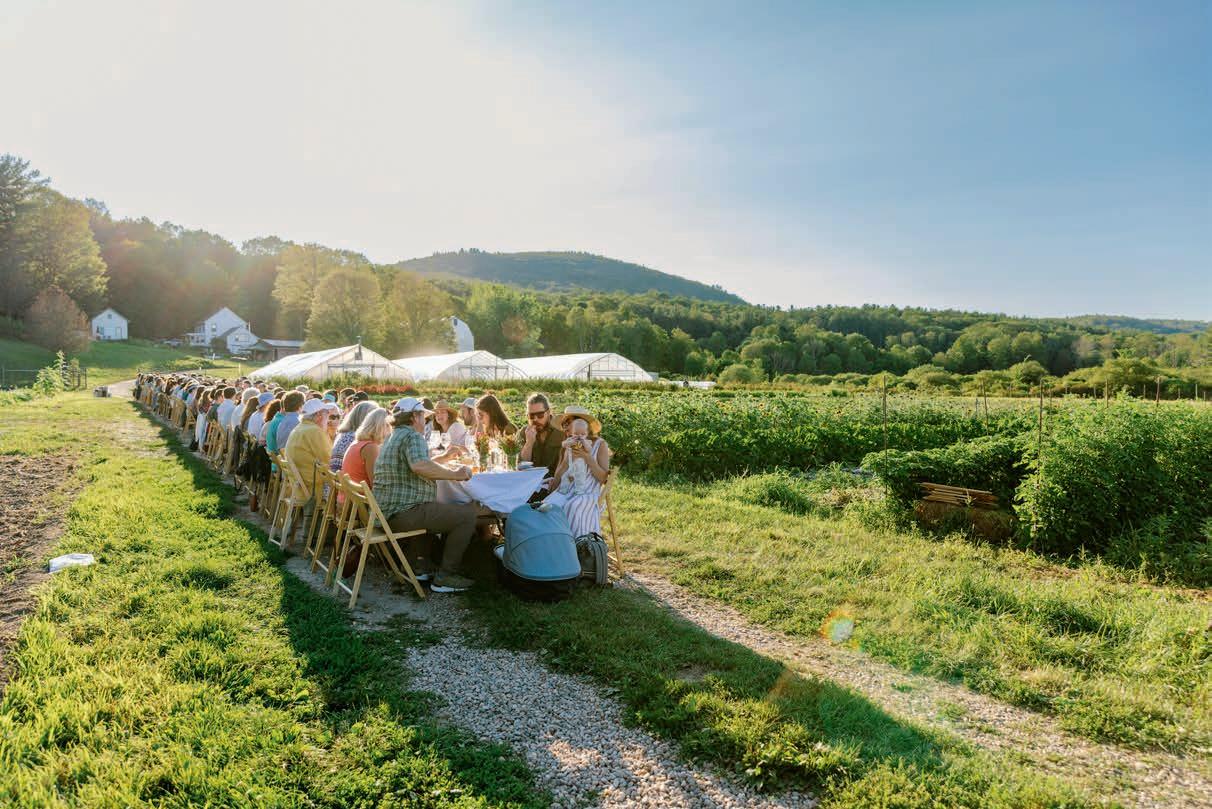

➜ POP. 7,172 | MEDIAN HOME $505,000

Support of local farmers is fierce in Great Barrington, a culinary cradle in the Housatonic River Valley. Indeed, in this small town named one of America’s best by Smithsonian magazine, a closer look confirms a conscious commitment at every level of eating and drinking. Restaurants raise their own meats and produce. Barrington Brewery makes its beer with solar power. SoCo Creamery sources dairy for its ice cream from a family farm (and makes its own cookie dough, to boot).
But Great Barrington shows its eco-mindedness in other ways, too. e town’s embrace of “green” burials. A cohousing cluster of sustainably built cottages, recently featured on Dwell ’s website. An environmentally friendly approach to weddings at Saint James Place, a cultural center and event venue where “micro weddings” sidestep the 1 billion pounds of trash that U.S. nuptials generate annually. ere’s more. e Appalachian Trail Conservancy has designated the town an “Appalachian Trail Community” for its dedication to the legendary hiking route. At Re ll GB, locals can restock on lemongrass laundry soap and work toward zero waste. Karen Allen Fiber Arts features natural- ber sweaters that the actress weaves herself. And at Rubiner’s Cheesemongers & Grocers, the motto “Cheese is our thing” feels like an understatement as you survey the bounty of smallfarm artistry displayed like edible platonic solids. Conscious and tasty living: It’s de nitely something to chew on. —A.G.
This coastal town hums with art, music, boating, and hiking. Home of the Maine Farmland Trust, it also has one of Maine’s largest food co-ops, a solarpowered firehouse, a town Climate Crisis Committee, and an Ecovillage cohousing community. Pop. 6,938; median home $370,000
While skiers know it as a home base for Killington, Rutland is quietly gaining fame as a sustainable-energy capital. It has the most solar power per capita of any New England city, with its Stafford Hill Solar Farm alone producing enough electricity to run 2,000 homes. Pop. 15,807; median home $265,000




➜
Avillage of North Kingstown set on western Narragansett Bay, Wickford can feel a bit like an island, with water views in every direction, even in the slivers between buildings. Streets uncoil like rope, with sea captains’ houses leaning back from the sidewalks. Dogs amble past with their people in tow. Mellow light smooths the rose-brick storefronts. Shade trees line up like parade spectators. It’s hard to believe you’re just 25 minutes from the bustle of Providence.
Recently named one of America’s 10 best historic small towns in a USA Today poll, Wickford has one of the densest collections of 18th-century houses in New England. It makes sense that “people whose hobby and love is restoring houses” are drawn here, says one longtime resident. Preservation is a fast track to tting in, bolstered by groups like HistWick and Historic North Kingstown. e local art scene, too, gets a big boost from the 400-member-strong Wickford Art Association, host of the annual summer Wickford Art Festival. But there’s a lot to be said for simply cruising the compact downtown, with its engaging assortment of storefronts clustered mostly on Main and Brown streets. From vintage furniture at Eclectic Bungalow to ne art at Five Main, and to clothing boutiques, pottery, Celtic jewelry, and yarn, it’s a ne excuse to slow down and soak up your surroundings. —A.G.
WORTHY ALTERNATIVE: WOODSTOCK, VT
Woodstock has three—count them—National Register Historic Districts. At its heart is a lovely town green bordered by the 1892 Woodstock Inn and streets filled with buildings from late 18th to late 19th centuries. Plan a side trip to the Marsh-Billings-Rockefeller National Historical Park, whose 550 acres are anchored by a handsome 1805 mansion. Pop. 3,005; median home $1.05M
AFFORDABLE OPTION: SKOWHEGAN, ME
Your great-grandparents would feel at home in Skowhegan’s historic district, with its nearly 40 buildings dating from 1880 to 1910. History also resonates in the oldest continuously held state fair in the country, the 1946 Skowhegan School of Painting & Sculpture, and the local movement for preserving heritage grains. Pop. 8,620; median home $249,000


A salute to our favorite urban neighborhoods.
BOSTON, MA: At just 4.4 square miles, Jamaica Plain is packed with attractions that make life special. “JP” is popular with both locals and visitors for its many green spaces, including the Harvard-owned Arnold Arboretum. There’s also brewing stalwart Sam Adams; creative eateries like Tres Gatos, a tapas bar that’s also a book and record store; and the jewel-like Jamaica Pond, with its rowboat and sailboat rentals.
PROVIDENCE, RI: Below Brown University on the East Side sits Fox Point, a city neighborhood that still feels intimate, even a touch secluded. It’s made for walking and biking, or just hanging out in parks along the harbor. Narragansett Brewery, New England’s oldest, makes its home here, while Wickenden Street invites browsing amid a trove of antiques and collectibles shops.
PORTLAND, ME: Maine’s biggest city has long been seen as a foodie beacon, and the Munjoy Hill/East End neighborhood more than upholds that reputation with places like Jing Yan Tavern, Cong Tu Bot, and the Front Room. In warm weather, hungry crowds head to the Eastern Promenade, whose views of Casco Bay are the backdrop for some of the city’s best food trucks.
BURLINGTON, VT: The Old North End (or O.N.E.) is a residential neighborhood north of bustling Church Street Marketplace and adjacent to UVM. Among its enticements are Battery Park, with its fine lake vistas; Intervale’s gardens and trails; the youth theater Very Merry Theatre; and funky stores like Junktiques, which draws artists and even celebrates the art of bartering.
WORCESTER, MA: While the canal itself was covered up long ago, residents of the Canal District know their neighborhood features some of Worcester’s best hidden gems, alongside heavy hitters like the Worcester Ice Center and Polar Park, home of the city’s Red Sox affiliate. The Worcester Public Market, meanwhile, would be a star attraction anywhere. —Kevin Koczwara

You crave clean air and outdoor space to spare, but you’re still a bit tethered to a job, a business, or life in the big city. And, truth be told, you’re more than a little accustomed to dining at the restaurants of celebrated chefs. And wandering into world-class galleries whenever you want to spruce up your place. Is there really a country retreat where you can work remotely and gain far more than you sacrifice? Where you’re 20 minutes from a MetroNorth train that can deposit you in the heart of Manhattan in less than two hours… yet even closer to a riverside stretch of the Appalachian Trail?
Yes, there is. It’s Kent, in far western Connecticut: the town Yankee famously named best for fall foliage. Sublimely scenic, surprisingly sophisticated, Kent claims three state parks within its borders, along with an independent bookstore, high-end decor showrooms like RT Facts, and restaurants headlined by Ore Hill—chef Tyler Anderson’s contemporary farm-to-table venture—just named to e New York Times’ annual best-inAmerica restaurant list.
You’ll have robust Internet here. And you’ll get used to the occasional dropped cellphone call. After all, working from home is all about exibility. You’ll have that in spades as you rub shoulders with other balance seekers walking their tots to preschool, snagging bestsellers at a library book sale, or tapping keyboards and sipping frozen frappamochas at 45 on Main. Increasingly, the transplants aren’t just urban escapees. ey’re down-to-earth families who simply want it all. —
Kim Knox BeckiusWORTHY ALTERNATIVE: BARNSTABLE, MA
While your kids are at sailing camp, you can be captaining your own enterprise. Barnstable’s seven welcoming villages are more connected than ever to the world beyond Cape Cod, thanks to posh coworking spaces, high-speed ferries, and added flights from the town-owned airport. Pop. 48,916; median home $690,000
AFFORDABLE OPTION: BERLIN, NH
If you’re itching to put the emphasis on remote, Berlin may be the workat-home hometown for you. The mountain views and square footage you’ll score in this former mill town on the Androscoggin would cost a bundle anywhere else. And the city’s first new mayor in 14 years is actively enticing entrepreneurs. Pop. 9,425; median home $180,000

As small cities across New England plot their comebacks, St. Albans offers an inspiring look at what’s possible. Less than two decades ago, city leaders launched a plan to reverse a decades-long decline that had taken its toll on not just Main Street, but also the “spirit of the city itself,” says city manager Dominic Cloud. The revival began with a $3 million reimagination of downtown, which brought wider sidewalks, more trees, and the kinds of pedestrian-friendly areas that feel welcoming to visitors and locals alike.
Today, Main Street features a thriving food and drink scene, a terri c bookstore, and a robust summer farmers’ market in Taylor Park. Elsewhere, new buildings have gone up, historic ones have been restored,

and multinational rms have set up shop. In a state that has struggled with declining population, St. Albans has seen its number of residents climb 16 percent since 2010.
Of course, this being Vermont, one is always close to the outdoors. Lake Champlain is on the doorstep, while the Hard’ack Recreation Area, a 95-acre public property, features an old-school ski hill, miles of hiking trails, and a year-round pool that stays a balmy 85 degrees even in the depths of winter. Community pride, meanwhile, is front and center during a wealth of annual events, from a winter carnival to special parent-kid dances (the Daughter Gala and the Son Shindig) at the all-new city hall.
“People come here and they see just how much is happening, and they ask, ‘Is
WORTHY ALTERNATIVE: SALEM, MA
Since 2001, Salem Main Streets has been a driving force in this North Shore city that’s anchored in no small part by the Peabody Essex Museum, the nation’s oldest continuously operating museum. And Boston, 15 miles south, is just a short commuter-rail ride away. Pop. 44,482; median home $585,500
AFFORDABLE OPTION: KEENE, NH
The splashy renovation of Keene’s historic Colonial Theatre continues to draw attention to its reenergized downtown. Keene State College’s pretty little campus flows into a central district with what’s been touted as the world’s widest paved Main Street, locally grown restaurants and shops, and one of the best art and music scenes in the state. Pop. 23,047; median home $330,000
it always like this?’ ” says Kelly Viens, a St. Albans native and the city’s longtime recreation director. “And my answer is always the same: ‘It really is.’ ” —Ian Aldrich

Just two hours from New York City or Boston, Chester settles into the nooks and crannies of hilly terrain along the banks of the Connecticut River, a mere 10 miles north of Long Island Sound. In a region shot through with sparkling waterways, Pattaconk Brook ducks under Chester’s Main Street, threading itself through a compact downtown that’s friendly, attractive, and cosmopolitan while still keeping close to its small-town New England character.
Character is key here: ough settled in 1692, Chester can be a bit Auntie Mame, with her “life is a banquet” attitude. It’s an artists’ enclave dotted with galleries and restaurants. It’s a walking town that “draws creative people,” according to one shopkeeper. It’s “a great town for kids and dogs,” says another. A full dance card of events, meanwhile, includes a Sunday farmers’ market, a Fourth of July road race, the Chester Fair (since 1877), and a townwide tag sale in May.
But Chester’s roots are curled around history, too. From April through November, the 1769 Chester-Hadlyme Ferry [pictured above] runs passengers across the Connecticut River to the century-old Gillette Castle, dribbled onto the cli s like an eccentric, oversize sand castle. e Old Burying Ground creaks with tombstones from the 1700s, and the 1868 Chester Fife & Drum Corps is one of the oldest continuously active groups of its kind in the nation. And through all this, a beautiful river runs. —A.G.

WORTHY ALTERNATIVE: PORTSMOUTH, NH
Portsmouth’s modest footprint belies all that it packs in: thriving arts and culture, au courant dining, colorful historic homes, and that town-withina-town, Strawbery Banke Museum. The Piscataqua River runs alongside pretty Prescott Park, which hosts a full-bore summer extravaganza of outdoor entertainment. Pop. 21,956; median home $711,000
AFFORDABLE OPTION: GREENFIELD, MA
Sitting at the confluence of three rivers, Greenfield is a scrappy combo of rural and forward-thinking (its mayor calls it “rurban”). The first designated “green community” in Massachusetts lures visitors with diverse restaurants, vintage shops, local breweries, a pair of marquee music festivals (Green River and Wormtown), and the showstopping Franklin County Fair. Pop. 17,768; median home $320,000
amariscotta would fall into the prettiest percentile of New England towns even if there were nothing to see beyond its dreamy little harbor on the tidal river that shares its name. It’s a classic coastal scene, complete with pleasure boats at anchor, a rollicking restaurant on the pier, and a white church spire closer to heaven than the treetops. But there are other visuals that make the town where Adam White set his 2022 bestseller, The Midcoast, a place where you’ll spend an inordinate amount of time snapping photos. From the ginormous banana splits at Waltz Soda Fountain, which hasn’t changed much in 75 years, to the luminous sunsets looking west toward the Great Salt Bay, preferably from the deck at Round Top with a cone of farmfresh lavender ice cream in hand, there are sweet scenes galore to document.
Put down roots here, and your family may soon be growing… half-ton pumpkins. Of all the events that bring this community together, fall’s annual Pumpkinfest & Regatta is the zany zenith, and it all begins on Seedling Sunday in May, when townspeople

WORTHY ALTERNATIVE: OLD LYME, CT
The Connecticut River meets Long Island Sound near this town that’s so alluring, an Impressionist colony sprang up at the 20th century’s turn. Picture yourself taking art classes at the Florence Griswold Museum, paddling the Great Island salt marsh, and making coffee runs to an architecturally distinct Dunkin’. Pop. 7,628; median home $560,000
AFFORDABLE OPTION: ST. JOHNSBURY, VT
If the Northeast Kingdom is Vermont unfiltered, St. Johnsbury is its red-brick Victorian outpost of civilization. It’s so cultivated, in fact, that its library houses about 100 framed masterpieces, and its most heartwarming attraction, Dog Mountain, is equal parts outdoor paradise for pups and enduring work of art. Pop. 7,364; median home $225,000
adopt plants that will produce the giant pumpkins destined for use as art (or boats). Don’t imagine for a moment, though, that Damariscotta is lacking in more erudite culture. It has two resident theater companies and a cinema. It hosts Salt Bay Chamberfest concerts. Its library is supported handsomely by a volunteer-powered used bookstore that Yankee has named the state’s best. And the Peace Gallery brings neighbors together to stretch, create, and meditate. —K.K.B.

enter yourself at Exeter’s classic town bandstand, and you’ll feel pulled in all directions—but that’s a good thing. The densely packed downtown will fuel you with perfectly brewed coffee at D Squared Java, distract you with Water Street Bookstore’s whip-smart picks, and feed your art-collector fantasies at galleries like Exeter Fine Crafts. You’ll also get a hefty hit of history: Founded in 1638, Exeter is filled with fine old buildings that hint at stories churning just under the surface, partly due to its proximity to the coast (eight miles) and its odd commingling of rivers (one sweet, one salty). The Squamscott and the Exeter entwine just behind the shops and cafés of Water Street, making Exeter a kind of thriving seaport without a sea.
Walk down Water Street to Swasey Parkway, and you might nd a weekly farmers’ market or festival. You’ll also encounter a half-mile path that hugs a riverbank once lined with schooners and gundalows, but which today sees kayaks and the crew boats of Phillips Exeter Academy. at storied prep school has an outsize presence here, abutting downtown with a lovely 675acre campus lled with walking trails galore and a generous helping of academic brick. And don’t miss the nearby American Independence Museum, which holds an annual post–Fourth of July party to mark the delivery of the Declaration of Independence to Exeter on July 16, 1776. —A.G.
WORTHY ALTERNATIVE: PROVINCETOWN, MA
It could easily take all day to absorb the diversions of Provincetown’s Commercial Street, with art galleries, waterside eateries, fragrant Portuguese baked goods, handicrafts and tchotchkes, meticulously kept historic homes, and that most glorious of pastimes: people-anddog-watching. Pop. 3,664; median home $2.08M
AFFORDABLE OPTION: BRATTLEBORO, VT
Cradled by steep hills along the Connecticut River, this artsy enclave packs its downtown with galleries, music venues, theaters, a food co-op, and cool restaurants. Also within an easy stroll: the Vermont Jazz Center, the Vermont Center for Photography, and the Brattleboro Museum & Art Center. Pop. 7,346; median home $329,000


T WAS A CRISP OCTOBER AFTERNOON
in Hardwick, a hardscrabble town of 2,900 souls in Vermont’s Northeast Kingdom, and the door to the Civic Standard was wide open. Kids on their way home from school helped themselves to free muffins. A woman with jittery hands took advantage of the Internet access to figure out how to catch a bus to the next town for her jobtraining program. A couple in Carhartts picked up some free tulip bulbs to plant in preparation for a spring tulip festival, a Hardwick tradition from the 1950s that the Civic was hoping to revive. Posters from the Civic’s eclectic series of events—concerts, bonfires, trivia nights, haiku workshops, karaoke—lined the walls.
The Civic Standard occupies a ramshackle red clapboard building on Main Street filled with threadbare couches, rickety tables, and random coffee mugs. Like a college dormitory lounge, it exudes the comforting vibe of a place you can’t possibly mess up any further. It was the home of The Hardwick Gazette for 133 years, until the newspaper’s new owner stopped printing during Covid and eventually handed the building to the Civic to support its “weird experiment,” as cofounder Rose Friedman puts it.
Vermont’s media, arts organizations, and community leaders all agree the Civic Standard is something new and vital, although nobody is sure what the heck it is. When I pressed her, Rose described it as an exploration of what might happen when you combine art and necessity instead of keeping them separate. “Like, if you take the soup kitchen and the theater as two extremes, what’s the place where they converge?”
That question has preoccupied Rose since her years at Bread and Puppet, the celebrated political theater troupe headquartered in nearby Glover. Rose met her husband there, and in 2007 they formed Modern Times Theater, which brought puppet shows and vaudeville skits to underserved places like Hardwick, a town that holds a heterogeneous mix of families that have been scraping by for generations and next-gen farmers and artists drawn by the region’s good soils and gorgeous landscapes.
The Modern Times shows were hilarious and popular, but over time Rose began nurturing ideas for a new kind of social theater—one that would internalize the Bread and Puppet ethos of “living the society that you would like to see flourish,” she said, and could be truly integrated into the life and imagination of a town. “I kept saying, ‘I just need a door on Main Street… I just need a door on Main Street.’”
Now she had one, and it was being put to full use. In the kitchen, a 9-year-old girl named Kaydence was making a giant pan of apple crisp for the free supper the Civic throws in the adjacent pocket park each Wednesday; on hand to


offer light guidance was Civic cofounder Tara Reese. Since it was fall, Tara had set up her old cider press in the park, and locals were already stopping by to unload baskets of backyard fruit.
Nearby, Kaydence’s father, a 30-year veteran of the New England restaurant scene who was tatted up from the tips of his toes to the top of his bald head, was using his one night off to cook the main course, a surprisingly sumptuous ratatouille. “It’s kind of a karma thing,” he explained when I asked him why he’d volunteered. “I feel like I could use a little more.”
A teenager named Dean was pulling Halloween costumes out of a closet and filling a rack for the Civic’s upcoming costume swap. He had a curtain of black hair in front of striking blue eyes, a death-metal T-shirt, and the skittishness of somebody not accustomed to human kindness. Rose and Tara had met him the year before, when they taught a cooking class at the high school called “Recipe for Human Connection.” “He was a total jerk,” Tara confided to me. “Like, ‘Screw you, Tara!’ Every day. And I was like, I’m gonna get to you somehow.”



Here was a new way for a small town to tell the story of who it was. A new way to make sense of it all.


But he dropped out of school before she got the chance. After that, she saw him on the street almost every day, and after six months of overtures, he finally came inside and ate some food. “I think he didn’t have many options,” Tara said.
So they put him to work. He’d just been hired as the Civic’s first employee, 20 hours per week. It turned out he could make a mean snickerdoodle. And he admitted to me that he’d actually had a more favorable impression of them than he’d let on. “They were kind of annoying, because they were always telling me to do my dishes. But they’re actually awesome people. They always have a good attitude.”
Dean also let it slip that he was newly homeless. An extremely rough family situation had ruptured once and for all, and that was that. He’d spent the previous night in an old greenhouse. Rose and Tara were working their connections to find a temporary solution while keeping all the usual Civic chaos on track. The Civic Standard was about to launch its next major undertaking—a pop-up haunted house in an abandoned garage up the street—and the first meeting was taking place immediately after the community supper. Rose was working her phone to round up a crew big enough to pull it off.
Expectations were high. The Civic had just finished its first big show, “Developed to Death,” a dinner-theater murder mystery featuring Hardwick citizens playing both themselves and fictional characters. The show sold out its
Rose and Tara and Erica became fast friends, bonding over the realization that their exceedingly different journeys were somehow the same.
initial run and then added a second run that also sold out, and suddenly the Civic was having a moment.
“We’ve had requests from three other towns,” Rose told me. “‘Could you come and talk to us about how to do this in our town? Like, can you just give us the script?’ But it doesn’t work that way. To tell you to do what we did makes no sense at all, because what we did is so particular to Hardwick.”
And yet, that specificity may be what makes the Civic Standard such a compelling model for other towns struggling to find ways to bring their citizens together. What happens if you look internally to generate the cultural life of your town? And what happens if you make giving and reciprocating the foundation of that culture? And what happens if you lower the barrier to participation as close to zero as possible?
No one knows yet. But a lot of people are watching.
THE BEACON THAT WOULD BECOME THE CIVIC Standard emerged from the worst darkness. On a Friday evening in January 2020, Tara’s 17-year-old son, Finn, took his own life. Finn was a remarkable kid—star of the baseball team, class president, and that rare individual who could mix comfortably with people from all walks of life— and his death devastated the town.
A few days later, people from every corner of town gathered around a bonfire at the high school for a memorial service. “He didn’t want different politics, and different wealth, and different lifestyles to divide people,” Tara told the local paper. “All he wanted was for the different kinds of Hardwick to come together.”
Through all her suffering, she never lost sight of that goal. “It seemed really pressing to me to make sure that didn’t go away,” she told me.
In that bleak winter of 2020, Rose and Tara hadn’t yet
bonded, even though they lived around the corner from each other and had friends in common. “It was this very small-town-Vermont thing,” Rose explained, “where we’d both been told bad things about the other one. Like, ‘Don’t be friends with that person. She’s whatever.’”
But in the wake of Finn’s death, people organized a meal train for Tara and her family, and Rose signed up. She dropped off a basket of roast chicken and potatoes from her farm, and received a heartfelt thank-you note in reply. “And I was like, Why would I ever think this woman was not somebody to be friends with? And she was doing the same thing,” Rose said. “So then we said to each other, ‘Let’s go for a walk.’ And on that first walk, we basically imagined the Civic Standard.”
Before Finn’s suicide, Tara had been dreaming of opening a bakery, a place where people could hang out. Rose had been programming events for the local grange. Both were troubled by the hardships of life in the Northeast Kingdom. “You can really feel the isolation here, the extremes of a rural place with hard winters,” Rose told me. “The population is small enough that you can tell who is seen and who is invisible.”
(Continued on p. 102)



When talking about a photographer, we often refer to their “eye,” as if what is seen through their lens explains what emerges for us as viewers. And the photos you see here certainly reflect the keen and restless eye of Greta Rybus, whose work has often appeared in Yankee as well as in many other publications. And with her brand-new book, Hot Springs (Ten Speed Press), her eye takes readers on a world tour of 14 countries. “Hot springs have helped shape the culture of these places—what does that look like?” she says.
But to understand the depth of Rybus’s work, you need to know as much about her heart as her eye, and how she is inspired to show how people care for their places, and each other.
Raised in the Mountain West with stints overseas, Rybus came to Maine after college to intern for a Portland photo agency—the only work o er she had received. “I fell for Maine, how its landscape could be both harsh and nourishing,” says Rybus, who still lives in Portland today.
As a freelance photojournalist, she carries versions of the same cameras she used in college. “I want to think about equipment as little as possible,” she says. “I want to think about the experience.” And the breadth of her experiences is vast, from immersing herself in the world of wild sheep and the Mainers who care for them, to capturing the haunting moments of a home in Senegal being washed into the sea—an event, she says, that changed her life and spurred her desire to show climate change not as an abstract concept but as a burning reality.
To make her delicately beautiful landscapes and portraits, she strives to find intimacy and empathy with her subjects. “I’m asking people to be vulnerable” to what she calls “an interview with my camera,” she says. What she learns with her heart shows up in her eye, and we feel them both. —Mel Allen
To see more of Greta Rybus’s work, including a preview of her new book, Hot Springs, go to gretarybus.com.

LEFT: Three miles off the Maine coast is a trio of mostly barren islands— Little Nash, Big Nash, and Flat—inhabited only by wild sheep, the descendants of a flock first raised by a lighthouse keeper’s daughter on Little Nash in 1916. “The islands and the people who carefully and respectfully tend to the flock have become great inspirations to me,” says Rybus, who has made this place the focus of an ongoing multiyear project. “They’re by far the thing I love documenting most in this world.”
OPPOSITE: In Senegal, a man looks through a door that just hours before had led to his family’s bedroom—the back of the house had washed away. The powerful image is part of Rybus’s “Climate Stories” project, during which she interviewed and photographed local people around the globe to discover how climate change affected their everyday lives.
PREVIOUS SPREAD: Ever since Rybus moved to Maine in 2011, she’s found endless inspiration in its rugged and beautiful landscape. In this image, taken on assignment for the state’s tourism office, she shows what Camden Harbor’s iconic Curtis Island Lighthouse looks like from inside a lobster boat’s pilothouse.


OPPOSITE: In this image from Rybus’s “Valley Eulogy,” a project that speaks to her own family’s history in the American West, cowboys prepare for a roping event at the annual rodeo in Ennis, Montana. “I’ve thought a lot about how Maine reminds me of Montana; both places have a deep connection to the natural landscape and feel protective of that connection. It’s behind my impulse to photograph fishing, farming, homesteading, and ranching.”



LEFT: One of Rybus’s favorite images from her new book, Hot Springs, is this portrait of a construction worker building a new road in Pamukkale, Turkey, to make the historical sites around a thermal complex more accessible. “It’s common while working on projects that I’m initially introduced to members of upper management to learn about a place, but the most meaningful connections will usually be found among the workers,” she says.
OPPOSITE: Though she spends much of her time immersing herself in the lives of other people, Rybus often looks at her personal world through the camera, too. “Each year my partner and I carve out a little time to go somewhere beautiful in the summertime. We try to get off the grid, somewhere without Internet or electricity. One year we visited this tiny cabin on Maine’s Schoodic Peninsula, where we could hear the ocean while we slept.”



Taken for an Atlas Obscura article titled “The Lost Art of Growing Blueberries with Fire,” this image remains “one of my favorite things I’ve ever photographed,” Rybus says. It shows Nicolas Lindholm, owner of Blue Hill Berry Co. in Penobscot, Maine, practicing the centuriesold indigenous tradition of burning wild blueberry barrens by hand to facilitate crop growth. While many of Lindholm’s fellow growers rely on mechanized burns, he sets out with a drip torch each spring to burn the hay that he spread across the barrens months before; helping to control the burn is a crew of family and friends armed with backpack water sprayers. For Lindholm, it’s one way to improve his odds in the chancy business of growing wild blueberries. “We’re dealing with a perennial crop in its native homeland,” he told Atlas Obscura. “There’s so many things that are out of your control. You gotta have a strong heart and be somewhat of a gambler.”
BELOW: During the two years Rybus spent capturing images for Hot Springs, she visited thermal waters that ranged from “simple, silty pools in the landscape“ to architectural marvels like the Gellért Spa in Budapest, shown here. “All the time, I was struck by the way nature provides for us and all the ways we use hot water for adventure, community, collectivity, spirituality, and connection.”
OPPOSITE: While on assignment for Travel & Leisure, Rybus caught the light of serene happiness in the eyes of a girl who’d just been swimming in a cove on Deer Isle, Maine. Though Rybus was trained in photojournalism courses to document society’s problems and challenges—and often suffering and corruption—she says she’s most interested in finding images of “joy, reciprocity, community, and connection... there’s as much to be learned from joy as there is from pain.”





An experimental home created by UMaine engineers o ers hope for the a ordable-housing crisis and for the future of Maine’s timber industry.
BY JULIA SHIPLEY


Spare in its looks but dramatic in its impact, this small building on the University of Maine’s Orono campus is the first-ever 3D-printed house made entirely with bio-based materials—making the structure fully recyclable.


eyond a vast parking lot brimming with cars, and a field filled with last summer’s goldenrod, the printed house huddles by itself—a one-story structure with a roof that curves like shoulders.
Diminutive compared with the magisterial buildings spread across the University of Maine in Orono—a rare campus designed by Frederick Law Olmsted—this structure, a cross between a cottage and a Quonset hut, wasn’t built in a conventional way. That is to say, over the course of months, using lumber and nails, sawed and hammered by people wearing tool belts and clinging to ladders. It was three-dimensionally printed by a futuristic-looking machine using “bio-based” materials—namely, 10 tons of sawdust.
Last March, as a cold rain fell, I ducked inside. The foyer was warm, cozy—an immediate reprieve. I noticed its walls, which aren’t smooth, but textured like horizontal corduroy and feel ever-so-slightly cat’s-tongue-rough to the touch. Another novelty are the corners: Instead of meeting at crisp right angles, its walls arc into the ceiling.
Otherwise, the one-bedroom, one-bathroom house has a familiar layout and is furnished as if it already belongs to someone with a yen for neutral hues. A beige blanket drapes across a queen bed with matching pillows. An ivory-colored wool rug spreads across the floor. There’s a little desk nook with an open laptop near a window. In the bathroom, a white porcelain sink and tub gleam. A tray of mugs basks
on the kitchen counter, and a gray crock of cooking utensils stands by the stove. Natural light pours through several tall windows at the front and back of the house. Across from the kitchen area, a manila-colored couch and two matching chairs cluster by a coffee table. Above, a wide-screen TV plays a video loop of the house’s fabrication.
In the sped-up time-lapse video, an enormous robotic “pen” is in frantic constant motion, pivoting-shiftingswerving, as its “nib” deposits contiguous beads of “ink.” The ink? Sawdust. As the pen moves, the house magically emerges, a gingerbread-colored wall rising from the laboratory floor. There are seemingly no people on the premises, but if you scan the footage carefully: A phantomlike man wearing a blue hard hat and safety jacket pops in sporadically to inspect “the print,” as the house materializes.
This 600-square-foot abode—which has hunkered behind UMaine’s Advanced Structures and Composites Center (ASCC) since its installation in November 2022— has stood strong and snug through a range of Maine’s weathers. Amid heavy snowstorms, a minus-30-degree polar vortex, winds of over 50 mph, and a wave of steamy summer days, it’s maintained a constant temperature of 60 to 70 degrees, courtesy of its deep insulation and two heat pumps.
The world’s first bio-based 3D-printed house—the brainchild of two men who grew up on opposite sides of



: Understated, low-slung furniture and a neutral color palette ensure that the home’s textured walls and other 3D-printed features are the stars of the show. And in keeping with its “accessible to all” ethos, the home was decorated with chic but affordable pieces from places such as Target and HomeGoods.

LEFT: Custom-made by Illinoisbased Ingersoll Machine Tools and unveiled at UMaine in 2019, this $2.5 million 3D printer ranks as the largest in the world.
BELOW: An artist’s rendering of UMaine’s planned 3D-printing facility, the Factory of the Future, an initiative of the school’s Advanced Structures and Composites Center (ASCC).
BOTTOM: ASCC founding executive director Habib Dagher led the project to construct a 3D-printed house using mainly wood “residuals”—things like sawdust, scrap lumber, and construction debris.

One of Dagher’s slogans, posted in the meeting room next to the 100,000square-foot lab, reads: “None of us is as smart as all of us.”





Weather watching is as ancient as mankind. When you give the gift of precision weather instruments from Maximum, you are inviting the recipient into an ages-old tradition and a new hobby that will last a lifetime. With models that measure wind, temperature, pressure, tides and more, each unit is handcrafted in New England for enduring quality. See our full selection of styles and finishes perfect for the ocassion. SHOP NOW AT MAXIMUM-INC.COM







































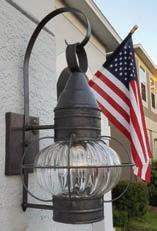

(Continued from p. 40)
can coat the back of a spoon. Add the lobster mixture to the pan and stir until well combined. Add the cooked pasta to the pan and stir to combine. Add a ladleful of the pasta water to thin the sauce a bit, if you’d like. Taste, and add salt if needed. Serve hot, topped with gremolata. Yields 4 to 6 servings.
BREAD PUDDING
Cider Hill Farm | Amesbury, MA
If you find yourself standing before a commercial doughnut robot as it turns out roughly 40 dozen cider doughnuts per hour—all of which need to be dusted with cinnamon sugar and lined up in rows for bagging—don’t panic. You may break a few, but is that so bad? Like Lucy and Ethel at the chocolate factory, you’ll find that the evidence is edible. At least, I did.
Our day at Cider Hill Farm in Amesbury was a celebration of farming,



SAVOR THE SUMMER SWEETNESS OF BEACH PLUMS ALL YEAR ROUND WITH THIS JAM RECIPE FROM LIGHTHOUSE KEEPER’S PANTRY (YARMOUTH, MA): NEWENGLAND.COM/PLUM-JAM
family, and apples. Cider Hill was started by Eleanor and Ed Cook, who handed it over to son Glenn and his wife, Karen, and their sons, who then expanded the property to include a massive farm store, bakery, and cidery. With field manager Grigore Chitas and his family, they’ve added acres of vegetables and stone fruits and a cutting garden.
It’s a big operation, but even after sampling all that bounty, you’ll probably still head to your car with a bag of warm

cider doughnuts (which are best enjoyed fresh). In the unlikely event of leftovers, use them as a delicious foundation for this simple bread pudding.
Salted butter, for the pan
6 cider doughnuts, broken into bite-size pieces
1 large apple, peeled, cored, and chopped
1½ cups half-and-half
¼ cup granulated sugar
2 large eggs, lightly beaten
1 teaspoon vanilla extract
¾ teaspoon ground cinnamon
½ teaspoon table salt
Vanilla ice cream and maple syrup, for serving
Butter an 8-by-8-inch baking dish. Arrange the doughnut pieces and chopped apple in the baking dish.
In a medium bowl, whisk together the half-and-half, sugar, eggs, vanilla, cinnamon, and salt. Pour this over the doughnut and apple pieces. Let this sit until liquid is absorbed, at least 20 minutes and up to overnight.


Twenty minutes before baking, preheat your oven to 350°F and set a rack to the middle position. Once the oven is hot, bake until the custard is set and the top is golden brown, about 30 minutes. Cool and serve with a scoop of ice cream and a drizzle of maple syrup. Yields 4 to 6 servings.
Pelham House Resort | Dennis Port, MA



Like many New Englanders, I’ve been a chowder essentialist, believing that the best chowders are achieved by coaxing the maximum favor from a minimum of ingredients. Then I made this herbscented chowder with chef Dan Coté at the Pelham House Resort, and I was a changed woman. A sprinkling of dill and—stay with me—oregano not only stands up to the briny clam and bacon flavors, but also enhances them.
As was the case with many places we visited this season, the Pelham House is a family operation. Owner John McCarthy learned the business from his father, Bob, who first bought the hotel in 1997. Today, Pelham is an
ever-expanding phenomenon, with two sister properties, a bakery, and a farm, all set against uninterrupted views of Nantucket Sound. If you make it to Dennis Port in March, you can check out the large function room that John has transformed into an off-season roller disco. And while you’re there, be sure to try the chowder (or make it at home).
1 pound Yukon Gold potatoes, diced
2 teaspoons kosher salt, plus more for cooking water
8 slices thick-cut bacon, diced
3 tablespoons salted butter
1 medium onion, diced
2 stalks celery, finely diced
2 teaspoons dried dill
1 teaspoon freshly ground black pepper
½ cup all-purpose flour
1 quart (four 8-ounce bottles) clam juice
2 cups chopped clam meat
2 cups light cream
2 tablespoons chopped fresh oregano leaves
Chopped fresh dill, for garnish
Bring a medium pot of salted water to a boil and add the potatoes. Cook until tender, 10 to 12 minutes, then drain and set aside.
In a large pot or Dutch oven over medium heat, cook the bacon, stirring often, until golden brown, 5 to 7 minutes. Use a slotted spoon to remove the bacon from the pot and set aside. Add the butter, onion, celery, dill, salt, and pepper and cook until the onion is translucent, about 6 minutes.
Add the flour and cook, stirring constantly, for about 2 minutes. Add the clam juice 1 cup at a time, whisking after each addition. Add the potatoes, clams, any liquid from the clams, and the cream. Simmer until the clams are firm, the chowder has thickened, and the flavors have combined, 10 to 15 minutes. Taste and season with additional salt and pepper, if you’d like. Just before serving, add two-thirds of the cooked bacon and the oregano. Serve topped with a sprinkle of the reserved bacon and fresh dill. Yields 8 servings.


(Continued from p. 53)
environments for great cormorants, spruce grouse, kittiwakes, and the Atlantic puffins who frequent nearby Machias Seal Island. Feeling up to a real identification challenge? About two dozen species of warblers are springtime visitors. 5/24–5/27; cobscookinstitute.org
MAINE MAPLE SUNDAY WEEKEND, statewide. As spring arrives, the Pine Tree State becomes the Maple Tree State. On the weekend of the fourth Sunday in March, nearly 100 of Maine’s maple producers hold open houses to show how sap is boiled down into syrup—and to offer tastes of their sweet elixir on ice cream, as candies, and in baked goods. Many sugarhouses also have hayrides, face painting, and other activities for kids. 3/23–3/24; mainemapleproducers.com
DAFFODIL AND TULIP FESTIVAL, Stockbridge. The imposing shingle-style mansion at Naumkeag, the former Joseph Choate estate, is a secondary attraction in April and May, when more than 75,000 daffodils and tulips take center stage at the Trustees of Reservations property. The blooms cover eight acres, and visitors can buy bouquets and container plants at a shop alongside the greenhouse. The first floor of the mansion will be open for selfguided tours. Advance ticket purchases are strongly recommended. Check website for details; thetrustees.org

MAY DAY FESTIVAL, Kennebunk. The Puritans disapproved of May Day and its dancing around the Maypole, but modern New Englanders have loosened up. For proof, head to Kennebunk on the first Saturday in May for the seaside town’s festival featuring a Maypole dance, a parade, a farmers’ market, live music, basketmaking and other crafts workshops … and a lobster toss (not sure what the Puritans would have made of that). 5/4; kennebunkmaine.us
MCLAUGHLIN GARDEN AND HOMESTEAD, South Paris. With more than 125 varieties of lilacs and gorgeous displays of phlox, daylilies, hostas, irises, primroses, and other spring-blooming favorites, one of Maine’s best-loved gardens was the vision of Bernard McLaughlin, “the dean of Maine gardeners.” Mother’s Day weekend marks the beginning of lilac season and the opening of the garden’s two acres of colorful plantings and its pond, rock, and pollinator gardens. Perennials and wildflowers are on sale from then through October. mclaughlingarden.org
CIDER HILL FARM TULIP FEST, Amesbury There’s almost always something going on at Cider Hill, but this is a special time because Tulip Fest is a participatory event. That’s right: When tulips are in bloom, from late April to mid-May, farm visitors are invited to pick and purchase their own blossoms. It’s the kickoff to a spring and summer of pick-your-own strawberries, raspberries, blueberries, and flowers galore. 5/4–5/5 and 5/11–5/12; ciderhill.com
DUCKLING DAY, Boston. Move over, Mom, and make way for Duckling Day, Boston’s celebration of Robert McCloskey’s beloved children’s book, held every year on Mother’s Day. Children dress like ducklings and parade through city parks, with the premier event taking place at the ducklings’ literary home, the Public Garden lagoon. The procession to the famed duckling sculptures begins with games, music, and performers on Boston Common. 5/12; friendsofthepublicgarden.org
VILLAGE, Sturbridge. In late February and early March, Old Sturbridge Village demonstrates the entire maple sugaring process—from tapping trees to “sugaring off”—as it was done in rural New England in the early 19th century. Learn how techniques have evolved over time, from traditional Native American methods to today, and check out all the maple goodies to taste and purchase. Friday–Sunday, 2/23–3/17; osv.org
NANTUCKET DAFFODIL FESTIVAL, Nantucket. Nantucket goes daffy on the last weekend in April, when the island’s Garden Club celebrates warm days with a daffodil show at the Bartlett’s Farm greenhouses. The four-day event also features an antique car parade, a tailgate picnic in ’Sconset, and Saturday fun at Children’s Beach, where kids are invited to join in a Daffodil Hat Parade. And to add some traditional flavor to the season, Morris dancers perform at locations throughout Nantucket. 4/25–4/28; daffodilfestival.com
SWAN BOATS’ OPENING DAY, Boston . It all started with Richard Wagner’s opera Lohengrin , and its scene in which the title character rides a swan-drawn boat to a damsel’s rescue. That gave Robert Paget the idea of launching pedal-powered boats featuring stern-mounted swans on Boston’s Public Garden lagoon. Nearly 150 years later, Paget’s descendants still







Because small groups do big things.


Did you know North America’s longest-running tour operator has been based in New England since 1918?
That’s a wicked long time.
With more than a century of experience, you can trust Collette. Our small group tours are designed for just 14 to 24 travelers, with accommodations and experiences that larger groups can’t always reach.
Satisfy your curiosity on journeys worth sharing, with immersive cultural connections you won’t find in any guidebook.

Curious? We have the details – Scan the QR code, call Collette at 855.403.0105 or see your travel professional and ask for Collette.
gocollette.com/explorations

What better way to hear about Ireland’s folklore than from a seanchaí, a traditional Irish storyteller?
The thatched cottages of Glencolmcille were made for exploring...but only by small groups.
• Hit the streets of Derry in Northern Ireland to learn about the city’s turbulent political history from a local guide.
• Skip the bus tour and get a unique perspective of Dublin during a city walk led by a guide formerly affected by homelessness.
Get a taste of Ireland’s traditional flavors (and characters) during lunch in a local pub.
 In Kilkenny, try your hand at a traditional Irish game of hurling.
In Kilkenny, try your hand at a traditional Irish game of hurling.

February 20 – May 19

operate the boats, which commence their 15-minute cruises on the second weekend in April, when the gardens are full of spring blooms. Opens 4/13; swanboats.com
CHARMINGFARE FARM , Candia . The Manchester area’s biggest petting zoo and animal experience opens in May, with farm animals including dairy cows, sheep, draft horses, oxen and more ready to greet visitors. Pony rides and horse-drawn carriage rides are part of the fun, and a wildlife area (no petting!) is home to bears and a camel, a wolf, a bobcat, and a coyote. Opens 5/4; weekend horse-drawn “Maple Express” tours 3/8–3/17; visitthefarm.com
HERITAGE BREED BABY ANIMALS AT STRAWBERY BANKE, Portsmouth Portsmouth’s living history museum tells four centuries of stories through its remarkable collection of historic homes, but in springtime, it’s the animals’ turn. See heritage livestock breeds common on New England farms from colonial times to the present, including lambs, piglets, calves, and poultry, with breeders’ presentations for children and adults. 4/27–5/5; strawberybanke.org
the extensive gardens created by landscape architect John DeWolf at the turn of the 20th century. One of the gardens’ greatest glories is their array of more than 50,000 daffodils, in bloom during most of April. Take a casual stroll through the grounds, or reserve a spot for an afternoon tea worthy of the Gilded Age. Check website for details; blithewold.org
FAIRY GARDEN DAYS, Providence. Visitors to the Roger Williams Park Botanical Center greenhouses might be forgiven for believing that those photos of garden fairies, “taken” a century ago, might not have been a hoax after all. During the last two weeks of April, the greenhouses are dotted with tiny “fairy homes” made from natural materials found in the park— shelters, furnishings, and even little fairy place settings. Along with marveling at the wee folks’ lodgings, kids can enjoy scavenger hunts, story times, and more. Check website for details; providenceri.gov


NEW HAMPSHIRE MAPLE EXPERIENCE, Bethlehem . March is Maple Month in New Hampshire, with sugarmakers welcoming visitors throughout the state. One of the most enjoyable events is held at The Rocks estate in Bethlehem on weekends starting in mid-March. Learn the sap-to-syrup process from tapping to collecting to boiling, and wrap up the day with pancakes and syrup. 3/16–4/6 (check website for specific dates); forestsociety.org/the-rocks
TULIPFETE AT THE FARM AT WOLF PINE HOLLOW, Hancock . Apples, grapes, strawberries, even kiwis—they all abound at Wolf Pine Hollow. But the springtime stars are tulips. Starting in late April, TulipFete brings color-starved winter survivors to the farm and what’s been called its “never-ending tulip field.” Tulips are available for sale at the farm store, or in the cutting gardens. Don’t forget to bring the kids to meet the farm’s lambs, piglets, and baby goats. Check website for details; wolfpinehollow.com
DAFFODIL DAYS AT BLITHEWOLD, Bristol . Blithewold, the former Van Wickle estate spread across 33 acres on the shores of Narragansett Bay, splendidly preserves
LA GONDOLA, Providence. In Venice, gondolas operate all year. But in Providence, it’s spring that brings these romantic boats out onto the water. Authentically attired gondoliers pilot their crafts along the Providence and Woonasquatucket rivers on 40-minute trips; the price includes an ice bucket, glasses, and Italian wine biscuits to accompany passengers’ bottles. Yes, the gondoliers sing (if desired), and for a few dollars extra a musician will ride along. Check website for dates and reservations; gondolari.com
SHEEP SHEARING DAY AT WATSON FARM, Jamestown . Spread across 265 acres on scenic Conanicut Island, Historic New England’s Watson Farm has been cultivated since 1657. On Sheep Shearing Day, visitors are welcome to stroll pathways along Narragansett Bay, wander fields where livestock graze, and learn about time-honored agricultural methods still practiced by the resident farmers. (If you can’t make that weekend, good news: Bristol’s Coggeshall Farm has more shearing action on offer May 18 at the Sheep and Wool Festival.)
5/4; historicnewengland.org
WICKED TULIPS FLOWER FARM, Exeter, RI; Johnston, RI; Preston, CT. Take your pick of Wicked Tulips’ three scenic outposts— which open for farm visits only a few weeks each year—when their hundreds of thousands of bulbs burst into bloom. Mother Nature determines the dates for this glorious pick-your-own event, so keep an eye on the website for updates, as well as ticket sales. wickedtulips.com
BABY FARM ANIMAL CELEBRATION, Woodstock . The kids can meet the kids—not just baby goats but also lambs, chicks, ducklings, piglets, calves, and bunnies—at what’s heralded as the “cutest event of the year” at Billings Farm & Museum. Food trucks will be on hand, and the Farmhouse Scoop Shop opens for the season, too. 4/7–4/8; billingsfarm.org
POND SKIM, Killington . It’ll probably never be an Olympic event, but that doesn’t mean it’s not worth watching 100 bizarrely attired skiers and snowboarders rush downhill at Killington Resort, hoping they’ve built up enough momentum to plane across a frigid pond. There are awards for best skim and biggest splash—and spectators eager to see both. 4/13; killington.com
SPRING MAPLE OPEN HOUSE WEEKEND, statewide. The next-to-last weekend in March is when Vermont’s sugarmakers open their doors to maple mavens— and to anyone curious about how the spring sap flow boils down into the state’s signature product. There’ll be syrup to sample, and many producers will offer sugar on snow, a taffylike maple treat created when warm syrup touches winter’s cold remnants. And, yes, it’s traditionally served with pickles … or doughnuts, for the less adventurous. 3/23–3/24; vermontmaple.org
VERMONT MAPLE FESTIVAL, St. Albans
At this beloved three-day celebration of sugar season, food vendors’ offerings have a maple flavor, and tastings provide a chance to sample different grades. A maple-oriented “sappy” art show, a maple cooking contest, and pancake breakfasts extend the theme, as do Saturday night’s maple banquet and Sunday’s big parade. Live music, entertainment for kids, and craft, youth talent, and fiddlers’ shows round out the program. 4/26–4/28; vtmaplefestival.org
WORLD MIGRATORY BIRD DAY, Quechee
Join in a day of learning, crafts, and activities at the Vermont Institute of Natural Science (VINS) as it celebrates the long-distance fliers of the avian world. Take a tour of the songbird aviary, attend a live-raptor show, and get a bird’s-eye view of the landscape from the elevated Forest Canopy Walk. 5/11; vinsweb.org

Inn Victoria to Golden Stage Inn (13 miles) Chester, VT 802-875-4288
InnVictoria.com
Golden Stage Inn to The Governor’s Inn (10.7 miles)
Proctorsville, VT 802-226-7744
GoldenStageInn.com
The Governor’s Inn to
The Colonial House Inn & Motel • (6.7 miles) Ludlow, VT 802-228-8830
TheGovernorsInn.com
The Colonial House Inn & Motel to Inn Victoria (11.8 miles) Weston, VT 802-824-6286
CoHoInn.com




Christmas Farm Inn offers comfortable lodging, traditional New England dining, and a full-service spa as your perfect home base for nearby shopping and adventure. From weddings to couples retreats to family gatherings, maximize your White Mountains experience with us.
603-383-4313
christmasfarminn.com

The Boston Globe describes Fat Sheep Farm as “a magical place” offering amazing views from modern cabins. Soak in the sunset by the firepit, taste the farm’s bounty, try your hand at milking sheep, or attend a cheese-making or sourdough workshop.

Nestled in the beautiful green hills of New England, the Bedford Village Inn & Grand is a four-diamond property that perfectly blends historical character with a luxury boutique ambiance. Its 64 gorgeously designed rooms retain the rustic charm of days gone by, while simultaneously offering everyday modern comfort and amenities.
800-852-1166
bedfordvillageinn.com

Rediscover Hampton Beach, rated #1 in the United States for water quality. FREE activities: fireworks, concerts, sand competition, country music, children’s activities, talent show, circus show, fire show, yoga on the beach.

Spanning 700 acres, this resort offers activities for everyone, from horseback riding to clay bird shooting and boat rides. With luxurious accommodations, an on-site spa and salon, and exquisite dining, it’s the perfect getaway destination. A short drive from home— made to feel like a world away.
802-483-2311
mountaintopinn.com

Commemorating the 150th birthday of Thornton W. Burgess, acclaimed children’s author, naturalist, and conservationist. His timeless tales of Peter Rabbit and friends continue to inspire a love of nature, habitat, and wildlife conservation in our Green Meadow Forest exhibit.
508-888-6870
thorntonburgess.org
Gifts at 136 offers a large selection of fine crafts and art from Maine, including furniture, paintings, sculpture, jewelry, pottery, glassware, lighting, and more. Gifts at 136 has won multiple awards for its well-curated collection of accessible art. Open all year.
207-563-1011
GiftsAt136.com
Reconnect with past Editors’ Choice winners and see for yourself why they received Yankee Magazine’ s highest accolade.
802-436-4696
fatsheepfarmvermont.com
603-926-8717
hamptonbeach.org
Reconnect with past Editors’ Choice winners and see for yourself why they received Yankee Magazine’s highest accolade.
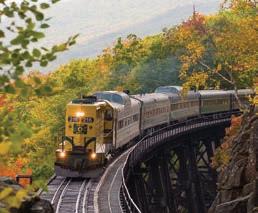

Conway Scenic Railroad offers a choice of heritage and scenic excursions. Take a step back in time and experience classic train travel on our trips to Conway and Sawyer River. Our Mountaineer offers a scenic journey over New Hampshire’s Crawford Notch.
603-356-5251 conwayscenic.com

A must-see New England destination that tells the shared history of Plymouth Colony and the Indigenous Peoples of the region in the early 1600s. Visit the 17thCentury English Village, Historic Patuxet Homesite, Plimoth Grist Mill, and Mayflower II.
508-746-1622 plimoth.org
Rediscover luxury lodging at The Inn at Thorn Hill. From couples retreats to weddings, experience personalized accommodations, inspired dining, a private wine cellar, and several spa packages set amidst the majesty of the Presidential Mountain Range in Jackson, New Hampshire.
603-383-4242 innatthornhill.com

Enjoy a quarter mile of sandy beach and docks on the shores of Lake Winnipesaukee. Lakeside cottages, apartments, and rooms available. Great location for fishing, hiking, kayaking, boating, and more. Family owned and operated since 1890.
603-293-4321
amesfarminn.com








Climb this historic 7.6-mile road to the summit of the Northeast’s highest peak— drive yourself, or take a guided tour. This must-do drive is America’s oldest manmade attraction. During the winter, take a tour on the Mt. Washington SnowCoach. Visit our year-round gift shops and award-winning bar and restaurant at the energyefficient Glen House Hotel.
603-466-3988
mt-washington.com
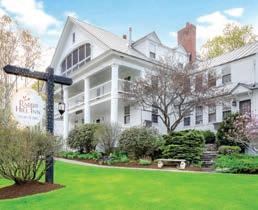
Nestled in Vermont’s pristine landscape, Rabbit Hill Inn beckons with luxury and charm. Unwind in premier accommodations, savor outstanding cuisine at 24 Carrot, and embrace outdoor adventure yearround. Your retreat awaits amidst mountains, streams, and New England’s tranquility.
802-748-5168
rabbithillinn.com

Steps from Bowdoin College in the heart of downtown, OneSixtyFive offers 16 elegant rooms, a pet-friendly cottage, and private events with locally sourced catering. Pub165 and our breakfast dining room are open seven days a week—the public is welcome.
207-729-4914
onesixtyfivemaine.com

Elevate your perspective on the new Forest Canopy Walk! Enjoy live raptor programs, nature trails, a store, and an adventure playscape for all ages. Featuring live bird enclosures, a remarkable reptiles exhibit, and a walkthrough songbird aviary.
802-359-5000
vinsweb.org
(Continued from p. 75)
But then Covid hit, and there would be no more bringing people together. “I couldn’t do theater,” Rose said. “And I was freaking out about it. Like, what does it mean to be in a culture where people can’t see shows together? What is left when you take that away? I was also thinking a lot about families where food access was scarce.”
So she decided to make soup and give it away in the grange parking lot. And to make it a party, not a soup kitchen. “Eating free soup is not immediately comfortable for everybody,” she explained. “But what if you get into a practice as a community of doing this thing together?”
She leaned hard on friends, spread the word on social media, and set up her table on a frigid January day. A friend baked bread. Others helped cook, including Tara. Rose did it the
next week. And the week after. And it turned out to be contagious. “People started bringing mittens and socks they’d made,” she said. “Then a dairy farm brought chocolate milk they’d bottled. Other people brought eggs. There was this table of bounty. And people were coming and filling shopping bags. And people stood around and talked until they couldn’t feel their toes anymore. It was just so satisfying.”
ONE OF THE PEOPLE WHO SHOWED up to check out the free-soup experiment was Erica Heilman. For seven years, Erica had been making a quietly revolutionary podcast called Rumble Strip. Each carefully crafted episode is an unvarnished vignette of a regular Vermonter’s life. “It’s about climbing into the firsthand experience of another person,” she told me. “And
you don’t have to like them, but you do have to love them.”
In that parking lot, Erica met Tara, who shared her story of Finn’s suicide and the way the town had rallied. Erica spent the next nine months interviewing Tara for an episode of Rumble Strip that aired in November 2021. At the end of “Finn and the Bell,” a tearful Tara relates the moments after Finn’s death, as she stood in the snow and felt the remnants of his spirit filling her. “It just sort of got in me somehow,” she says. “It was like infinite compassion for every single person that had ever lived, including me and including Finn for doing this. I remember saying out loud, ‘Oh!’ Like, I understood, for just a second, why we were alive. And it felt like it was for each other.”
The wrenching episode became a national sensation. It received a Peabody Award, the highest honor in broadcasting, and Rumble Strip was named a top podcast of the year by The New Yorker and The New York Times.

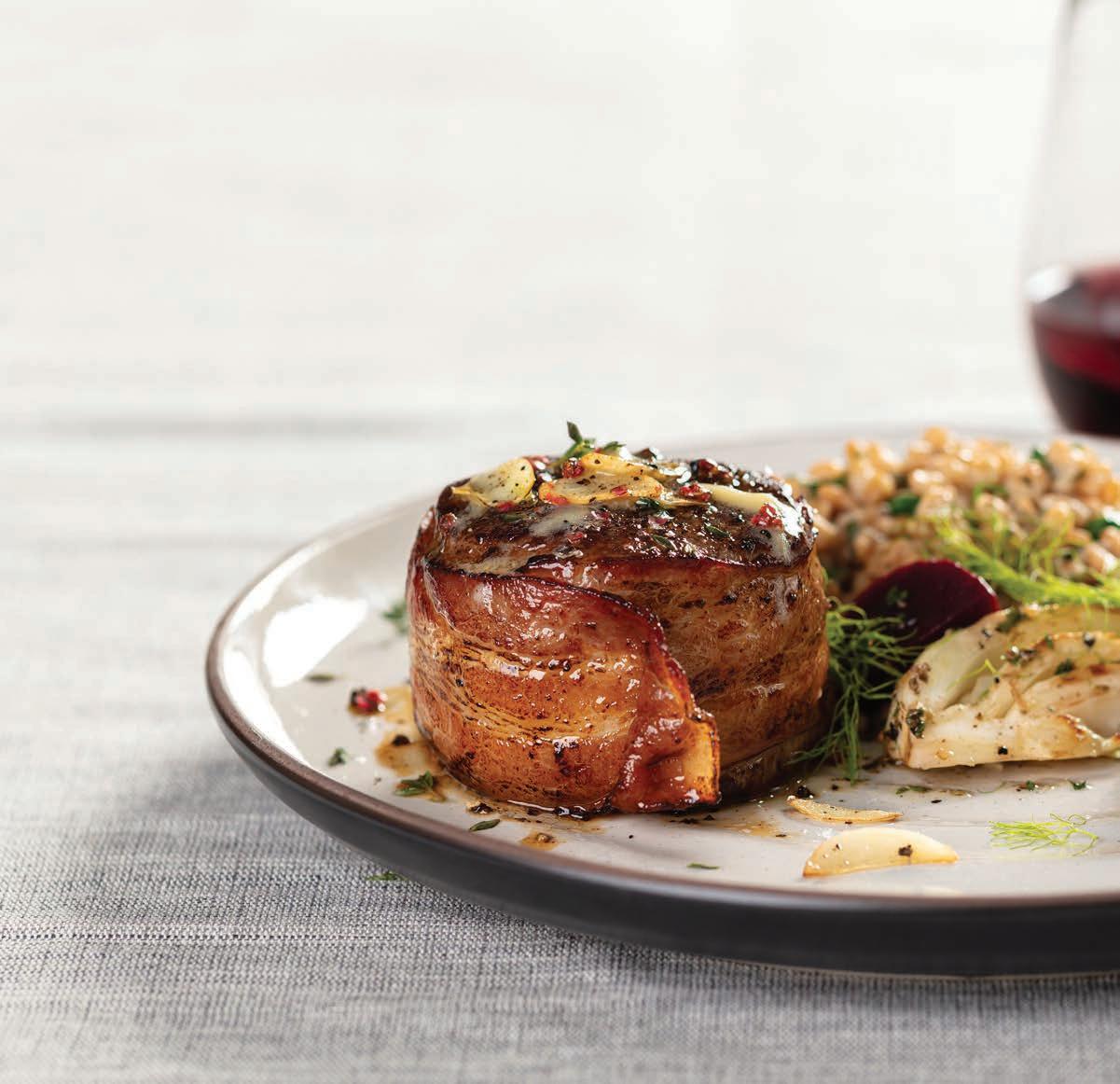



















ckle your puzzler!
Tickle your puzzler!

All puzzles 1000 pieces
$19.50 ea. + S&H
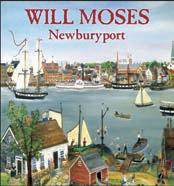




“Art to warm your heart & home.”
MT. NEBO GALLERY
60 Grandma Moses Rd.
P.O. Box 94, Eagle Bridge, NY 12057 1-800-328-6326
FREE color catalog is available featuring Will Moses limited edition Folk Art Prints, Books, Puzzles, Cards & More!
VISA MASTERCARD AMERICAN EXPRESS
VISA
PROMPT DELIVERY SATISFACTION GUARANTEED
Visit us on the web at www.willmoses.com
Applicable tax shipping extra
By then, Rose and Tara and Erica were fast friends, bonding over the realization that their exceedingly different journeys were somehow the same. “I don’t think that any of us knew what this was,” Erica said. “But I think all three of us had a deep curiosity about other humans, and how people find each other across boundaries.” Each, in her own way, was trying to solve the fundamental dilemma of being a loving consciousness trapped in a lonely body.
Later that winter, Rose and Tara decided to turn Tara’s family’s tradition of burning their Christmas tree on Epiphany into a community event. They put up flyers and spread the word: Come throw your tree on the bonfire! Free chili and cornbread! “It was a Civic Standard event,” Tara acknowledged. “We just didn’t know it yet.”
People came. Hundreds of people came. The high schoolers came and the homesteaders came and the theater geeks came. People arrived by Lexus and by snowmobile. Cars slip-slided in the snow and had to be pushed.
Perhaps it was a show of support for Tara. Perhaps it was desperation to do anything during Covid. Whatever it was, an entire town burned its Christmas trees together and stayed late, scraping frozen sour cream onto bowls of chili. “It was the party I always wanted to go to,” Erica said. At the end of the evening, the three women sat around the fire together, trying to figure out what had just happened, and how to make it happen again.
IN LATE 2021, WITH THE PANDEMIC having dried up advertising revenue, the owner of The Hardwick Gazette closed the paper’s downtown office for good. Failing to find a buyer for the tumbledown building filled with broken furniture and antique printing presses, he donated it to the Civic Standard. Down came the iconic hand-painted Hardwick Gazette sign, and up went the Civic Standard sign in the same style. The newspaper-y sound of the new organization was
Upson thinks every town could use an organization that playfully negotiates the middle ground between people and government. “[The Civic] is bringing down walls. I see a lot of trust-building.”
no accident: Here was a new way for a small town to tell the story of who it was. A new way to make sense of it all.
Rose and Tara didn’t waste any time rolling out an ambitious and somewhat ad hoc slate of programming. They taught the high school class. They gave away cupcakes on the first day of school. Trivia night. Darning club. Fiddle classes and jam sessions. Dinners in the park every Wednesday. So much stuff, with so little fanfare, that the practice of doing things with neighbors and strangers began to feel less like an event and more like a habit.
Their greatest asset turned out to be the building, with 133 years of civic life baked into its patina. They kept it run-down and ideology-free. “Early on, I asked them what flags they were going to fly,” David Upson, the Hardwick town manager, told me. “And they said, ‘An OPEN flag.’”
Slowly, their plans got bigger. They reached out to the American Legion up the street to team up for a karaoke night. It was packed, and it emboldened them for the big ask: How about a full-blown murder mystery? Four shows? With dinner service?
For Rose, that kind of event had always been part of the mission. “Sometimes you need that huge cathartic release that only art can provide,” she said. “The tiny touchpoints are very important, but you also need the show that takes months to build, the amazing moment where the whole





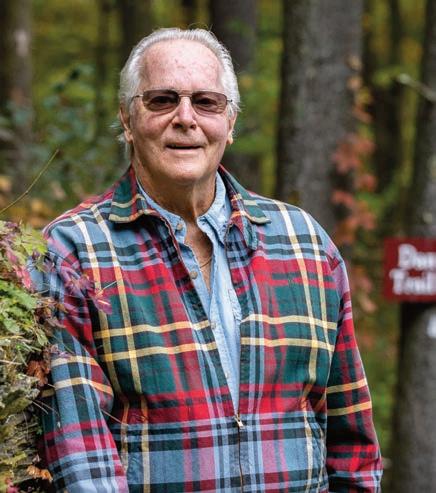











Quarry Hill o ers it all: a gracious, maintenance-free home with easy one- oor living and priority access to the fullest spectrum of care.
Enjoy all the beauty and cultural sophistication of Camden, Maine and discover your best future.



207-301-6116 quarryhill.org







The land of author James Herriot’s All Creatures Great and Small

community gets to go, ‘Whoa! Look what we can do!’”
Instead of “a cheesy cardboard script off the Internet,” Rose wanted the show to be all about Hardwick. The theme became “Softwick Falls,” a proposed development. The setting: a development review meeting. The developer would be murdered, of course. And everybody in town would be a suspect, of course.
The Legion was deeply skeptical. “They had big, big doubts,” Rose said. “Because it’s a weird idea. And then it sold out in a day. At that moment, their feelings about us changed.”
People were greeted as if they were attending a real meeting. They sat at folding tables with the cast and were served spaghetti and meatballs. They had their choice of bumper stickers: “Softwick Falls: Because It Doesn’t Have to Be So Hard” or “Keep the Hard in Hardwick.” Upson played himself and was a prime suspect.
Upson told me he’d been happy to let the Civic write him into the play. He thought every town could use an organization that playfully negotiated the middle ground between people and government. “It’s bringing down walls,” he said. “I see a lot of trustbuilding.”
More than 20 locals wound up acting in the play, with dozens more working behind the scenes or serving the meal. People hung on every unlikely plot twist. It was the town catharsis Rose had been looking for.
But the feeling was short-lived. Just a few months later, in July 2023, record rains fell on Vermont, bringing with them the state’s worst flooding in a century. As houses flooded, roads disintegrated, and Hardwick’s only motel washed away, Upson raced to open an emergency shelter at the high school. One of his first calls was to the Civic Standard. “I called Tara and said, ‘Hey, I need help.’ They have their people and they’ve built up trust, so people respond.”
Within hours, the Civic went into community-meal overdrive, marshaling dozens of cooks and delivering hundreds of meals to the shelter. They organized blanket drives. They coordi-
“I don’t think that any of us knew what this was,” Erica said. “But I think all three of us had a deep curiosity about other humans, and how people find each other across boundaries.”
nated the volunteer response. They rescued a 91-year-old man from his trailer as the land underneath gave way.
When the waters receded, the Civic turned out a hundred volunteers to muck out basements, leaning hard on new friends at the Legion and their pickup-truck brigade. Hill Farmstead, the celebrated brewery 10 miles up the road, put out a new beer called the Civic Standard and donated all the proceeds to the recovery efforts.
It was stunning how fast the Civic had gone from a hazy idea to an indispensable institution. To Erica, that can be traced to the jam sessions, the plays, the meals. “As it turns out, that’s the perfect practice for effective flood relief. All that connective tissue had been forming for over a year.”
IF YOU WANT TO DRAW A CROWD in New England on a lovely fall afternoon, just set up a cider press on Main Street. In the pocket park, Kaydence and I threw the first apples into the grinder at 5:30 sharp. Within minutes, a handful of small children had gravitated to the scene and relieved me of my duties. Over the next hour, they cranked their way through a mountain of apples while adults milled around them, wolfing down ratatouille. The woman who’d been looking for the bus to her job-training program filled some to-go containers and quietly slipped away. I sat next to a man who had recently moved to the area from Cape Cod. He said he’d chosen Hardwick, in part, because of the Civic Standard. “I saw their sign and got on their mailing list. It seemed like the kind of place I wanted to live.”
Dean replenished the water cooler one last time and then sat down and shoveled a mountain of apple crisp into his slight frame. Despite his situation, he was feeling pretty chipper. At Rose and Tara’s urging, the high school principal was putting him up until he could find something permanent. Better still, he was part of a new skateboard committee of local teens who would be meeting at the Civic to try to get a new skate park built. They had even scored a meeting with the town manager. (When I asked Upson about it, he said he’d been impressed to receive the invite from the kids through the Civic Standard’s email. “That’s democracy!” he said. “That’s giving these kids agency.”)
Best of all, Dean was about to try out for a role in the haunted house. He didn’t know anything about theater, but the Civic had comped him a ticket to the murder mystery, and it surprised him. “It was funny,” he told me as we ate. “Really funny.” Recently, out of the blue, he’d suggested to Rose that maybe he could be in a show sometime. So she mentioned the haunted house. Scare some kids. Freak out some adults. Oh yeah.
At 6:30 it was dark and the air had started to cool, but the crowd was larger than ever, so Tara stayed behind to manage the scene while a handful of us grabbed chairs and carried them up the street to the garage. There, amid the dust and old oil stains, about 20 volunteers brainstormed through the evening until they had come up with a plan that was true to Hardwick. A mysterious object that had washed up in the floods would be on display, and it would suck people into an alternative Hardwick-from-Hell. There would be a zombie potluck with disturbingly organic ingredients, a deranged selectboard, and a nightmarish open-mic night.
The meeting adjourned with everyone promising to rope in more volunteers for the set construction to come. To me, it felt daunting. They would need half the town to pull it off. But they would get it, of course. Everyone was in.




Never touched a trowel in your life? Been gardening at home for decades? Gardeners of every skill level always bene t from having trusted knowledge at their ngertips.
The Old Farmer’s Almanac’s Gardener’s Handbooks are loaded with advice and inspiration to guarantee success for every gardener.

EACH HANDBOOK INCLUDES . .
• step-by-step guidance on growing more than 30 vegetables or flowering plants
• planning advice to minimize maintenance and maximize harvests, color, and fragrance
• pages for notes and records
• tips for seed-starting and best timing for transplanting

• the lowdown on disease and pest prevention (and, if necessary, how to combat)
• fun and informative anecdotes from fellow gardeners
• charts and tables for ready reference
• and much more to help you achieve the gardens of your dreams!
(Continued from p. 90)
the world—was created to address two seemingly unrelated yet equally urgent issues: Maine’s dearth of affordable housing and its crumbling timber industry. But as I found out, the story of this house cannot be told without knowing how and why it is here, and why Maine’s infinite forest is at the heart of an ingenious plan to reimagine life for thousands of the state’s residents.
Afew miles east of the printed house is the Maine Forest and Logging Museum. Situated at the end of a dirt road within the university’s experimental forest, it’s a quiet spot: “Six people [a day] is as busy as it gets,” says the museum’s seasonal caretaker, Kevin Gericke. But to those who poke their heads into the main office asking for a map, Gericke recommends touring the reproduction of a 1700s-era sawmill. Down the trail, across the covered bridge, there it is: a timber-frame structure smelling like fresh-milled lumber. Made entirely from trees, it’s a building whose function is to mill yet more trees, to construct more buildings. And inside, at the point where freshly cut boards spill away from the saw blade, stand two barrels ready to collect the humble residue: sawdust.
Two centuries ago, when Maine separated from Massachusetts and became its own state in 1820, vast northern timberlands were suddenly up for grabs, drawing investors and fortune hunters. Lumberjacks felled white pine, hemlock, spruce, fir, and beech from Maine forests, furnishing logs that were floated down the Penobscot River to Bangor. By 1830, there were 300 sawmills surrounding Bangor, and soon the city’s fame as a wood producer spread around the world. In the 20th century, paper mills fed by wood pulp became Maine’s biggest employers. But time has not been kind. Today the timber industry is faltering, and most of the state’s mills have shuttered—all while the average price for the state’s limited housing stock has been driven up by
out-of-staters who relocated to Maine during the pandemic.
In downtown Bangor, beyond an entrance sign reading “Helping Today, Building Tomorrow,” two receptionists at Penquis are fielding endless requests for housing assistance. A nonprofit organization whose focus is eliminating poverty, Penquis oversees 50 different social services, of which 20 percent are directly tied to housing issues. “Home Is Key” reads a pamphlet in the waiting area. While I am there, a man in his 50s tells a receptionist he’s been living in his car, but now it’s been impounded. A woman carrying a toddler on each hip explains, “I need a place to stay.” A lady in her 80s is looking for help because she’s been evicted; new owners purchased the apartment complex where she’s lived for decades, and they’ve raised the rent far beyond what she can afford on her fixed income.
Later, with snow on the ground and temperatures in the upper 20s, I drive around Bangor with Penquis’s housing development director, Jason Bird. He points out a modest two-story with a “For Sale” sign. “They’re asking $185,000,” he says. “Probably two years ago, that would have been less than $100,000.” According to a 2022 report by the Joint Center for Housing Studies at Harvard, the income needed to buy an average Maine home is $130,000. But the report also found that in Maine’s biggest city, Portland, the median income is less than $62,000.
Less than a mile away, we pass one of several sprawling encampments that in recent years have hosted as many as 70 people. There are multiple tents and garbage bags and plastic coolers and other items clustered across the snowy field. “For years we’ve known about the housing crisis,” Bird tells me, “but now, everyone else sees it.” And after my tour with Bird, while leaving my downtown Bangor Airbnb I realize three people have spent the night sleeping across the street, by the front steps of the Penobscot County Federal Credit Union.

Yet as Heidi LeBlanc, Penquis’s chief operating officer, notes: There are small wins in this crisis. Over the past six months, Penquis has housed 20 families, helped five people avoid eviction, and gotten three individuals into temporary housing. An influx of new affordable and efficient small homes could change the lives of families they see every day.
Mark Wiesendanger’s family has been involved in Maine’s lumber industry for more than a century. However, for the past eight years, he has worked as the development director for MaineHousing, a 50-plus-yearold state agency that functions like a $2 billion bank to help people buy, rent, repair, and heat their homes. In 2019, Wiesendanger was walking in a parade alongside a float conveying the world’s largest solid 3D-printed object, a boat created at UMaine’s Advanced Structures and Composites Center, when he had an idea. In November 2019, he put that idea into an email to Habib Dagher, the ASCC’s founding executive director and a professor of structural engineering at UMaine.

moored in the afternoon sun
Quissett Harbor is as picturesque a harbor as one might imagine along the New England coast. It is a popular sailing destination off of Buzzards Bay. The inner harbor is loaded with many classic sailboats. Our Herreshoff, reflected in the calm water in the afternoon sun, is one of a fleet of almost 50 Herreshoff 12½ sailboats moored in the wellprotected inner harbor. The 12½ was designed in 1914 by Nat Herreshoff and is still in production today. These boats are universally acclaimed as one of the finest sailboats of all times. This beautiful limited-edition print of an original oil painting, individually numbered and signed by the artist, Forrest Pirovano, captures the calmness of the water and the unique appearance of this world famous sailboat.
This exquisite print is bordered by a museum-quality white-on-white double mat, measuring 11x14 inches. Framed in either a black or white 1½ inch deep wood frame, this limited edition print measures 12¼ X 15¼ inches and is priced at only $149. Matted but unframed the price for this print is $109. Prices include shipping and packaging.
Forrest Pirovano is a Cape Cod artist. His paintings capture the picturesque landscape and seascapes of the Cape which have a universal appeal. His paintings often include the many antique wooden sailboats and picturesque lighthouses that are home to Cape Cod.
P.O. Box 1011 • Mashpee, MA 02649
Visit our studio in Mashpee Commons, Cape Cod
All major credit cards are welcome. Please send card name, card number, expiration date, code number & billing ZIP code. Checks are also accepted.…Or you can call Forrest at 781-858-3691 …Or you can pay through our website www.forrestcapecodpaintings.com
Wiesendanger explained how his agency funds nearly all of the affordable housing created in Maine, which at the time needed at least 20,000 affordable units. But given the dramatic rise in construction costs, coupled with the labor shortage—demographically, Maine is the nation’s “oldest” state—MaineHousing was able to realize only 200 to 300 housing units per year, Wiesendanger wrote. At that rate, the state’s demand for affordable housing wouldn’t be met for a century.
An obvious way to tackle the problem would be to expand the construction labor force, but Wiesendanger thought advances like 3D printers might soon make those positions obsolete. Maybe, he proposed, this was an opportunity “to create a new type of housing … using new Mainebased wood-based technologies that would be durable and energy-efficient, and would benefit the local economy.” Furthermore, what if there were a way to reduce transportation costs for materials and labor? And what if the solution could showcase Maine innovation while also fulfilling a public need?
Dagher was intrigued. Born in Guinea and raised in Beirut—where he turned his bedroom into a chemistry lab—he had earned three advanced degrees in civil and structural engineering before arriving at UMaine in the mid-1980s. Not long after, he was walking along Portland’s seaport when he noticed heaps of hemlock trunks. “I guess they’re going overseas for somebody to make a product and sell it back to us,” a dockworker told him.
This led Dagher to apply for, and receive, the first of hundreds of grants to build a laboratory on campus where, among other initiatives, he and his team could develop new products, including wood composites, that utilized Maine’s timber. In 2008, for instance, they used raw materials from Maine forests to produce a blast-and-fragment-resistant tent for the U.S. Army Corps of Engineers. Subsequently, the ASCC’s engineers began innovating with the world’s
The world’s first biobased 3D-printed home was executed the same way a student might cram for an exam or churn out a term paper: in a series of hyperfocused, largely sleepless, pizza-fueled episodes.
largest 3D printer, earning Guinness Book World Record honors in 2019 for fabricating the world’s largest solid 3D-printed object, the same boat that Wiesendanger had seen. That same year they printed a 90-square-foot military communications shelter that was designed to fit on the back of a truck.
One morning in late 2019, having mulled over Wiesendanger’s email, Dagher turned to ASCC engineer Scott Thomlinson and asked, “Can you print a house in the next two weeks?” Thomlinson, a large-framed man who bides his time before speaking, considered the matter. “Maybe,” he said.
The world’s first bio-based 3D-printed home was executed the same way a student might cram for an exam or churn out a term paper: in a series of hyperfocused, largely sleepless, pizza-fueled episodes. By early November 2022, three years after Wiesendanger’s initial email, Dagher and his team were weeks away from debuting their first-of-its-kind-neverbeen-tried-before project, laboring inside the ASCC’s hangar-like laboratory at the campus’s east end.
Over the previous months, Dagher and his team’s attempts to address Maine’s housing crisis using inexpensive, abundant materials to manufacture a ready-to-inhabit home had been immersed in intense, confidential development. In the lead-up to the prototype’s unveiling, however, most of what they had to show for their efforts was a conference table’s worth of miniature one-story bungalows.
“Fail fast and cheap” is one of Dagher’s maxims, which explained the dozens of toy-size printed mod-
els, each representing an idea the team had tested on its way to designing a home that was recyclable but also fire retardant and handicap accessible and met all the building codes. These “failures” also helped answer key questions, such as whether the house should be printed as a single object or as a series of modules. And if the former were actually doable, how might they transport it to the building site? Or, if the latter was desirable, could they fit the modules together with no gaps at the joints?
Another of Dagher’s slogans, posted in the meeting room next to the 100,000-square-foot lab, reads: “None of us is as smart as all of us.”
Dagher is quick to credit his team for its holy-cow inventions, like the “bridge in a backpack” (actually a hockey bag) that contains all the materials necessary to construct a durable, noncorrosive, vehicle-bearing bridge, and that world-record-winning boat, “3Dirigo,” whose name was inspired by the state motto, translated as “I lead.” To date, the ASCC has registered 120 patents, created 14 spin-off companies, and won 40 awards for research excellence.
With deadline looming, Dagher and his team readied the four modules of the house that they’d printed individually using sawdust milled further into flour and combined with a corn-based binder. It can be confusing, they know, to conceive of “printing” a house. Visitors to the lab frequently express something along the lines of “How does a printer that spits out pages with words equate to a printer that can spit out a house?”
Team members explain, “Think of it like a giant pastry bag that’s piping out icing.”
Days before the November 21 unveiling, each of the modules— the living room/kitchen, the bedroom, the bath/foyer, and the porch—was hauled from the lab on the back of a flatbed truck and driven to the building site behind the laboratory, overlooking an open field backed by a four-acre parking lot. There, a crane moved each module into place, and electricians hooked up

the lights and heat pumps. Assembly took half a day. By nightfall on November 20, the once-empty patch behind the lab now hosted a printed house. Had you crossed the campus at dusk, you would have seen lights where they had never been, glowing from the windows of the university’s newest structure.
On an aggressively hot September day in 2023, six months after my first visit, I tagged along on a tour of the printed house. Crossing its threshold, I relished the home’s 65-degree coolness. The tour guide explained how before printing the house, Dagher and his team had tortured the building materials in their lab, subjecting them to prolonged extremes of heat, cold, dryness, and moisture. Embedded sensors in the finished house now collect data about temperature, moisture, and UV effects, part of an ongoing study of how the structure responds to Maine’s climate.
“It’s spacious,” observed one of the tour participants, Thom Rawson, associate professor at Japan’s Nagasaki International University. But prowling the bedroom, he noted, “There’s not much closet space.” Rawson continued his appraisal as if the place was for sale. Given that he’s 6 foot 8 “with a slouch,” his head skimmed the doorway. “Could they raise the ceiling?” he wondered. “I don’t want to be bonking my head all the time.” And the roof: “How does it handle the snow load?”
The team worked closely with a Portland architectural firm to ensure the house met all building codes. To the disappointment of curious visitors, however, insurance laws prohibit overnight guests. Presently, the house has no running water. And while the engineers intended the house to be powered by solar electricity, university officials nixed that idea. So for those in the market to purchase, the ASCC’s communications team explains that although the university owns the intellectual property to this prototype, “we are never going to be a [private] housing company.”
The sign out front proclaims the printed house’s true intention: “A bold solution to address the nation’s affordable-housing crisis.”
Between the front porch of the printed house and the vast commuter-student parking lot, there’s a few football fields’ worth of open space. This cricket-and-goldenrodfilled swath of land will be the home of UMaine’s Factory of the Future, slated to break ground this summer. Here, Dagher’s team will scale up production. The facility’s layout will resemble a “next-generation car-manufacturing line,” Dagher says, and its homes will be built in modules by students trained to operate a building-sized printer.
As Wiesendanger noted in his initial email to Dagher, the printed house can do more than address an affordable-housing problem—it can also address an industry problem. There are millions of tons of wood residuals in the Bangor region alone. The first printed house used 10 tons of it; by Dagher’s estimates, there’s enough nearby for the new factory to produce 100,000 more. It’s a potential supplyand-demand game changer not only in Maine, but also throughout New England and beyond.
The factory’s automated technology will allow for the production of multiple houses in a month’s time, versus the many months it takes to produce one conventionally built home. Through a partnership with MaineHousing and Penquis, nine of those printed homes are already spoken for and will be delivered to a site in Bangor to become the world’s first neighborhood of affordable bio-based printed homes.
Sometimes skeptical of technology’s promises, I reflect on my visit to the Maine Forest and Logging Museum’s visitor center, where a black-and-white video plays on a loop in a side room. In the video, a vehicle resembling a train engine chugs through the snow, pulling a series of sleds brimming with Maine timber. This is the Lombard steam log hauler, invented at the turn of the 20th century by Maine’s own Alvin Lombard.
Nicknamed “Mary Anne,” it traveled 5 mph, had no brakes, and took four people to operate. It replaced the work of 50 horses.
Other than a glimpse of a man jabbing a log with a peavey, a type of lumberjack tool, there are no people in the video. Instead it features panning shots of the iron behemoth blasting across the wood’s edge, spewing smoke and steam, towing part of the forest. Two of these obsolete machines hunker in the visitor center’s back room, where one can gawk at the most enduring aspect of Lombard’s invention. In 1900 he patented the log hauler’s continuous track tread, which became the prototype for all the tracked vehicles that followed—from the Sherman tank to the moon rover.
“I’m so glad they thought to document this,” museum caretaker Kevin Gericke said of the nine-minute video. “I mean, at the time this was cutting-edge!”
It strikes me that technology is an elastic word that can be applied to all manner of tools. The peavey is technology; Mary Anne is technology. Then I think about the time-lapse documentary video playing in the printed house on an endless loop, and I try to fathom how one day it, too, may become an antique sideshow.
Wiesendanger, who first lobbed his idea into Dagher’s lab just four years ago, looks forward to the day when the Factory of the Future can 3D-print multifamily homes with units that stack upward like Legos, because stand-alone houses aren’t ideal for cities. Yet even with ongoing improvements—the lab’s updated extruder head now prints 500 pounds per hour, compared with its original 150 per hour—questions remain. For instance, can the factory achieve a scale and level of efficiency great enough to drive the cost down?
A solution to endemic housing shortage isn’t going to happen overnight, Dagher concedes. But in the field where goldenrod ripples and crickets tick off the minutes till winter, an infinity of crumbs from Maine’s old forest industry—sawdust—may soon give rise to a new one.

Easy | The large screen, big buttons, simple menu, powerful speaker, long-lasting battery and Urgent Response button on the Jitterbug® Flip2 make calling, texting and getting help easier than ever.
Helpful | Whether you want to learn more about your phone, need a ride or have a health concern, our caring team is here to help, day or night. Enjoy peace of mind knowing you can count on our kind and knowledgeable, 100% U.S. based team to go above and beyond, even in an emergency.

















EnergAire continuously puri es up to 4,000 cubic feet (a large room) of air and makes it breathable and invigorating. Restores natural ion balance to unhealthy environments caused by industrial pollution, automobile exhaust, central airconditioning, and heating, smoke, dust, pollen, animal fur. . . removes microscopic pollution particles not removed by any other method of air puri cation. EnergAire was rated Number One for speed of removal of cigarette smoke by the leading U.S. consumer protection magazine. It has no noisy fan, no costly lter, and requires no maintenance. Uses less than 2 watts. 9" high. 3" diameter. Weighs less than 1 pound. $69.95
Made in USA

RODAR is the super-powerful professional ultrasonic pest repeller with up to 60 or more times the power of other devices — and power is what makes RODAR so e ective. RODAR ultrasound equals a jet engine — noise unbearable to pests but at frequencies humans and pets cannot hear. RODAR units are completely safe. RODAR drives pests out and keeps them from getting in. Handsome simulated walnut cabinet 5-5/8" high. Weight 1-1/2 pounds. Uses less than 5 watts. $99.95


90-day money-back guarantee — 12-month warranty.To order: Send cost for unit(s) plus $10.00 each for shipping and handling (in Mass. add 6.25% tax) by check, money order, MasterCard, Visa, or Discover number and expiration date to Micron Corp.












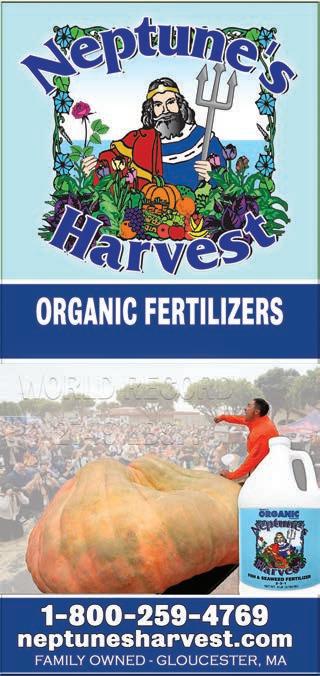



































(Continued from p. 120)
been so consistently warm and weak that it somehow feels like a breach of contract, the promise of an easy glide into spring rudely revoked.
It takes me nearly three hours to clear our drive, plus the two others I tend. By the time I’m done, the sky has stopped spitting and is breaking into intricate patterns. I park the tractor, haul water to the cows, then stand for a moment under that fracturing sky, watching it separate into more shades of gray than I would have thought possible. So many colors within the one; so many different ways of seeing something I thought I knew exactly how to see.
Later, after the storm is long past, I ski into the woods to a spot where the yellow birches grow so big they don’t even look like yellow birches anymore, the bark turned brown and roughened by age, the trunks thick and branches twisted in improbable ways. I think the birches are like very old people: hard to fathom but also strangely captivating, as if they’ve done something miraculous other than simply endure. As all of us must. As most of us do. When I tire of breaking trail through the new snow, I turn back, now gliding easy in my own tracks, back past the yellow/ brown birches and through a long sweep of maples. Dark is coming on, but later than I’ve grown accustomed to, almost 6 o’clock and still plenty of light to see by. Spring is close at hand. I can smell it on the air.
Spring. I awake to the distant sound of water rushing in the small creek that skirts the southern boundary of our land, and above that, the intermittent call of songbirds. I feel as if I should know which ones, but I don’t. Daylight coming on. It will rain soon. I can feel it even if I can’t quite see it yet. The floor creaks beneath my feet. After coffee and chores I pedal my bike up the long, steep climb to Cole’s Pond, the thawing road soft beneath my tires, beads of sweat amassing
along my brow. I ride under a strand of wire strung from the outstretched branches of maples on either side of the road; a hot line to a fence containing a herd of Angus who watch my passing with that particular bovine breed of curiosity: interested, but not too interested. Like really if they had anything better to do, they’d be doing it. There’s no grass for them yet, but it won’t be long. Two, three weeks. Another few minutes of climbing, and there’s the charred remains of the house that burned last month. It’s stunning to see the fire’s rude work, everything black and twisted into gross approximations of its original form. I don’t know the family, but I heard they made it out OK. So that’s good, at least.
By the time I’ve made the top of the climb and ridden back down past the burned house and under the hot wire, the farmer who strung it is out fixing fence, lines in his face like a treasure map. He waves, I wave. Morning. Mornin’. I look for the cows again but they’re nowhere to be seen, and I







guess they went and found something better to do after all.
A week of 60-degree days. Snow melts, rivers run, roads thaw. Sap flows, but the maple season starts late and looks to finish early, and the talk is that sugar makers down south have already pulled their taps, having made only a quarter crop.
I drive rutted roads to pick up loads of sawdust for the cows’ bedding. Yesterday we had rain that turned to snow overnight, and this morning the trees are newly frosted, there’s no sun, and we’re 25 degrees shy of 60. I shovel sawdust into the cows’ paddock, and there’s something about it that excites them; they run fast, short circles and fling sawdust into the air with their wide, wet noses. Later, maybe, I’ll see if I can shore up some electric wire and give them a little more room to roam, but for now I shovel and shovel as they run and fling, their whole world confined by a wood-slat fence they could breach in a heartbeat if only they knew how easy it would be.










Life in the Kingdom
Each year winter and spring do their dance, until one finally lets go and the other one moves ahead.
ILLUSTRATION BY TOM HAUGOMAT
inter passes as winter does, in fits and starts of snow and cold; in the pages of one book after another, the cat dozing on my chest while I read in the evenings before bed; in early-morning forays into the highelevation hardwoods at the top of the mountain road. There, I watch the sun rise through the leafless crowns of the maples and yellow birches, and eventually over the snowed boughs of spruce and fir, glad for the silence and the solitude and sometimes wondering how different my circumstances might be if it weren’t for snow and skis and cold and this big swath of land where I can
so soon find myself beyond the range of human sound.
It’s good to wonder these things, I think, at least from time to time, just as perhaps it’s good to wonder how to be of use in a world that spirals further and further out of control with every passing day. Though it’s true the answers don’t come easy; it’s true I envy those who have any sort of answer, or who seem not to wonder in the first place. In the evening, I read again. The cat dozes, and I doze with him, stars visible in the sky through the window above my head. In the morning I head back to the woods, where it’s always clear I
know nothing more than the last time I came here, or the time before that. But it’s also where knowing doesn’t seem to offer any kind of answer at all.
The narrow gravel lane we live on transitions between ice and mud and ice again, and Kyle tells me we’re going to need to increase the town’s budget for road material; he’s been waging an ongoing war against the ruts and potholes opened by the constant freeze/ thaw/freeze cycle, and the big piles down at the town garage are disappearing fast. We’ve had two mud seasons already this winter, and we might be on the cusp of a third. I vacillate between bemoaning the weather and wielding my own peculiar brand of stoic philosophy, which basically involves making up pithy affirmations and then sharing them as broadly (and frequently) as possible, a pastime that has not entirely endeared me to my family. “Comfort is where growth goes to die” is my favorite so far, though I acknowledge it’s not the most obvious response to a weak winter. But still: Comfort is where growth goes to die. You gotta admit, it’s pretty damn good.
On Friday comes the biggest storm of the season thus far, the snow beginning in the evening hours and continuing unabated throughout the night. In the morning there’s a solid 10 inches on the ground, and snow still falls. Historically speaking, there’s nothing unusual about a storm like this in early March, but this winter has




Few realize one of the biggest gem events on the planet occurred just 25 miles north of Portland, Maine. We’ve been mining gems in Maine for over two-hundred years. Something amazing happened in our Western Mountains
12 years ago. One of the richest finds of tourmaline in the world occurred just 25 miles north of Portland. The tourmaline find was amazing, called SparHawk, It had some of the prettiest green tourmaline ever found in Maine’s Western Mountains.
The large picture is a glimpse into one of the gem pockets discovered here. A cave in a cliff. Tourmaline crystals were covered with a type of white clay that when washed away revealed green tourmaline crystals of extraordinary color and clarity.
The large SparHawk tourmaline crystal held in the smaller picture came from the Silver Dollar Pocket and is now in the Smithsonian Museum in Washington D.C.


















